|
A
AGBU News Magazine, - Armenian Genral Benevolent Union
AIM - Armenian International Magazine, - Founding Editor Vartan Oskanian, The Fourth Millennium Society
Ararat, a magazine from AGBU, - Armenian General Benevolent Union
Ararat, A searchlight on Armenia, - The Armenian united association of London
Aregak - Armenian monthly - ԱՐԵԳԱԿ, -
Armenian affairs, - Editor : Charles A. Vartanes, Armenian national Council of America
Armenian Forum, - Gomidas Intitute
Armenian Institute News - ՀԱՅ ՀԻՄՆԱՐԿ, - Susan Pattie, Gagik Stepan-Sarkissan
Armenian Review, - Editor : Tatul Sonentz-Papazian
Armenian Voice - Newsletter for the London-Armenian Community, - Centre for Armenian information and advice B
Bardez, - Armenian Institute C
Canada Armenian Press, - Armenian Evangelical Church Toronto D
Diaspora, - Oxford University Presse G
Genocide studies and prevention, - International association of genocide scolars H
HOOSHARAR (The Prompter), - Armenian General Benevolent Union, Central Committe of América
Hye Sharzhoom - Armenian Action - ՀԱՅ ՇԱՐԺՈՒՄ, - California State University, Fresno Armenian Studies Program and Armenian Students Organization J
Jahagir - ՋԱՀԱԿԻՐ, - St John's Armenian Church of Gretaer Detrot
Journal of Armenian studies, - National Association for Armenian Studies and Research (NAASR)
Journal of The Society for Armenian Studies, - Society for Armenian Studies K
Keghard, -
Kroonk, - Committee for Cultural Relations with Armenians Abroad L
Looyce (ԼՈՅՍ), - Armenian Apostolic Church of Holy Resurrection - Sydney N
Narrec, - Fr. Abraham Malkhasyan
Nor Serount - Periodical of Holy Trinity Armenian Church, - Holy Trinity Armenian Church - Toronto O
Outreach, - Prelacy of the Armenian Apostolic Church of America P
Pari-Loor, - St Peter Armenian Apostolic Church
Polyphony - The Bulletin of the Multicultural History Society of Ontario, - Robert F. Harney
Pro Oriente, - Pro Oriente S
St. Nersess Theological review, - T
The Armenian Church, - Diocese of the Armenian Church of America (Eastern Diocese)
The Armenian Guardian, - Armenian Church Youth Organization of America
The Armenian Mirror-Spectator, -
The Eternal flame, - Apostolic Exarchate for Armenian in the USA and Canada
The Messager - ՍՈՒՐՀԱՆԴԱԿ, - Armenian Church of Our Saviour
The Monthly Bulletin of the Armenian Evangelical Church of New York, - The Rev. L. Nishan Bakalian
The Mother Church - ՄԱՅՐ ԵԿԵՂԵՑԻ, - Western Diocese of the Armenian Church of North America
The Treasury, - Fellowship of St. Voski, editor in chief Dr.André Markarian V
Voice, - St John Armenian Apostolic Church
AAGBU News Magazine | 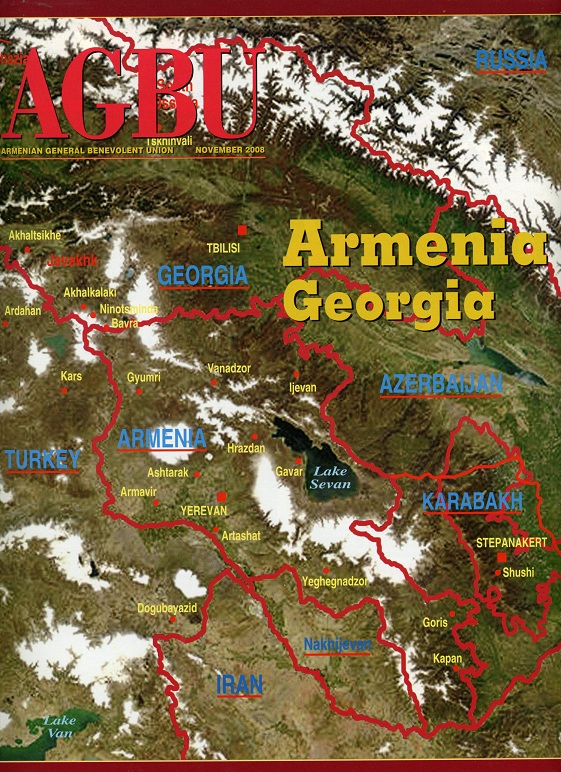 Rangement Rangement
Périodiques anglais
 | | Numéros disponibles : | Année 1991 (première année) : numéro 2
Année 1992 : numéros 3
Année 1993 : numéros 3
Année 1994 : numéros 1, 2, 3, 4
Année 1995 : numéros 2, 3, 4
Année 1997 : numéro 2
Année 1998 : numéros 2, 3
Année 1999 : numéros 2, 3, 4
Année 2000 : numéros 1, 3
Année 2001 : numéro 1, 3
Année 2008 numéros 1,2
Année 2013 numéro 1 (juin 2013) |
|---|
| Sous-titre : | |
|---|
| Adresse : | 55 East 59th Street, New York NY 10022-1112 |
|---|
| Téléphone : | |
|---|
| Auteur : | Armenian Genral Benevolent Union |
|---|
| Périodicité : | Mensuel |
|---|
| Abonnement : | |
|---|
| Début : | 1991 |
|---|
| Fin : | |
|---|
| Imprimeur : | |
|---|
| Description : | 25,5 x 30,5 cm, 48, pages, couverture illustrée en couleurs |
|---|
| ISSN : | |
|---|
| Comm. paritaire : | |
|---|
| Site : | |
|---|
| E-mail : | |
|---|
| Commentaire : | |
|---|
| Mise à jour : | 2013 |
|---|
|
AIM - Armenian International Magazine | 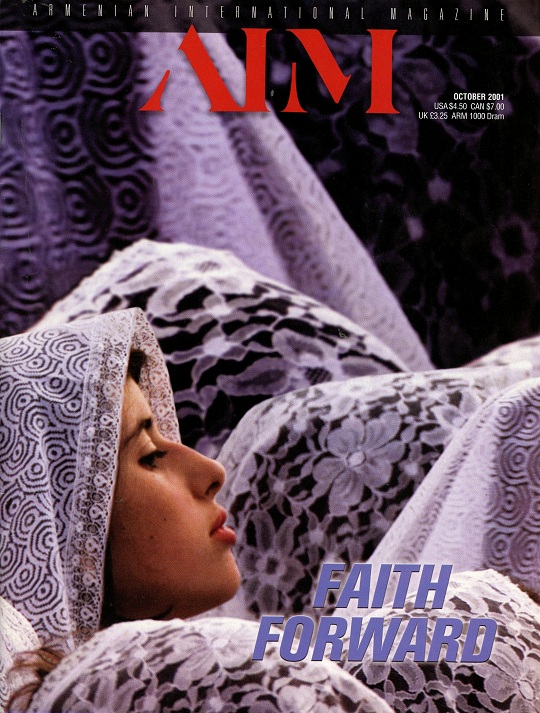 Rangement Rangement
Périodiques anglais
 | | Numéros disponibles : | Année 1990 : numéro juillet, septembre, novembre
Année 1991 : année entière sauf Novembre
Année 1992 : année entière 11 numéros
Année 1993 : année entière sauf septembre et décembre
Année 1992 : janvier
Année 1995 : janvier-février
Année 1996 : mai-juin, septembre-octobre
Année 1998 : février, juin, septembre, décembre
Année 1999 : mars juin, juillet
Année 2000 : février, mai, juin, juillet, aout-septembre, octobre décembre
Année 2001 : octobre, novembre |
|---|
| Sous-titre : | |
|---|
| Adresse : | 207 South Brand Boulevard, Suite 203, Glendale, CA 91204 USA |
|---|
| Téléphone : | Phone 818 246 7979 |
|---|
| Auteur : | Founding Editor Vartan Oskanian, The Fourth Millennium Society |
|---|
| Périodicité : | Mensuel |
|---|
| Abonnement : | Subscription rates for 10 issues, US: $55, Foreign: $65 |
|---|
| Début : | 1990 |
|---|
| Fin : | |
|---|
| Imprimeur : | |
|---|
| Description : | 21,5 x 27,5 cm, 80 pages, couverture illustrée en couleurs |
|---|
| ISSN : | 1050-3471 |
|---|
| Comm. paritaire : | |
|---|
| Site : | |
|---|
| E-mail : | |
|---|
| Commentaire : | Founded in 1990 Founding Editor Vartan Oskanian Founding Publisher Michael Nahabet 207 South Brand Boulevard, Suite 203, Glendale, CA 91204 USA Phone 818 246 7979 Fax 818 246 0088
Postmasters: Send address changes to AIM, P.O. Box 10793, Glendale, CA 91209, USA. |
|---|
| Mise à jour : | 2019 |
|---|
|
Ararat, a magazine from AGBU | 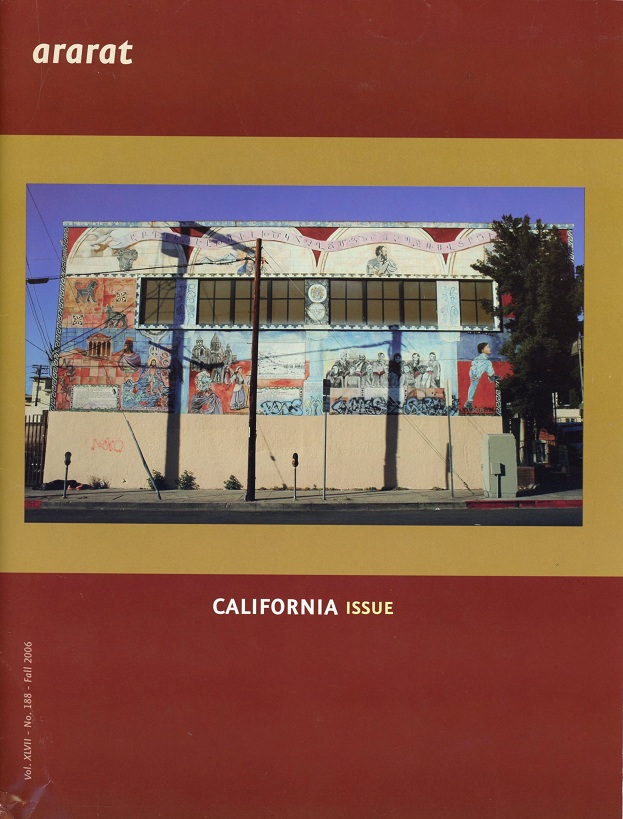 Rangement Rangement
Périodiques anglais
 | | Numéros disponibles : | 188 numéros disponibles, des années 1962-2006 |
|---|
| Sous-titre : | International quarterly |
|---|
| Adresse : | 55 East 59th Street - New York, NY 10022 |
|---|
| Téléphone : | |
|---|
| Auteur : | Armenian General Benevolent Union |
|---|
| Périodicité : | Trimestriel |
|---|
| Abonnement : | |
|---|
| Début : | 1960 |
|---|
| Fin : | |
|---|
| Imprimeur : | |
|---|
| Description : | 21,5 x 28 cm, couverture en couleurs |
|---|
| ISSN : | 003-7583 |
|---|
| Comm. paritaire : | |
|---|
| Site : | araratmagazine.org/ |
|---|
| E-mail : | |
|---|
| Commentaire : | Ararat has moved from print to web Welcome to the new Ararat. The decision by the Central Board of Directors of the Armenian General Benevolent Union (AGBU) to make the transition from a print magazine to an interactive electronic publication was based on two primary considerations: first, to continue Ararat’s proud tradition of literary excellence but in a more dynamic forum that can more easily reach a significantly larger number of people; second, to reach an expanded readership demographically, including young professionals across many professions globally. The new Ararat will have new posts on a weekly or bi-weekly basis.
The new Ararat will continue to publish quality fiction and essays. However, at the same time, we are looking to expand the variety of its contents, as follows: Current Affairs; Arts & Culture; Business; Education & Health; Fiction & Poetry; and Opinions. There will also be selective events listings, which will alert readers of events taking place that pertain to the aforementioned fields. Another feature will be Hot Topics Online or in Armenian Publications, which will contain links to existing articles, etc.
We encourage you to not only become a regular follower of Ararat but also spread the word about it online via Twitter, Facebook and other social media tools. In addition, we welcome your comments about the articles and pieces published, through the blog feature, which we envision becoming just as valuable a component of the magazine as the published material itself.
We look forward to hearing your suggestions for possible articles, essays, feature stories, etc. And we’d be delighted to entertain offers for submissions.
In its 50-year history, Ararat became not only the premier magazine of Armenian-American literature but also covered many aspects of Armenian history and culture. As such, it represents a valuable repository of materials for the study of these topics by scholars. Its collections constitute a unique holding in many public and private libraries across the United States. It is our hope and intention to not only continue this exalted tradition but expand and enrich it in the coming years.
— Aris Sevag, Editor
Ararat is an international quarterly of literature, history, popular culture and the arts published by the Armenian General Benevolent Union (AGBU), 55 East 59th Street, New York, NY 10022-1112.
Founded in 1906, AGBU (wwfw.agbu.org) is a non-profit philanthropic organization sponsoring educational, cultural, and social services throughout the world to preserve the Armenian traditions and heritage for future generations.
Contributions and editorial correspondence should be addressed to The Editor, Ararat, in care of AGBU, 55 East 59th Street, New York, NY 10022-1112. |
|---|
| Mise à jour : | 2011 |
|---|
|
Ararat, A searchlight on Armenia | 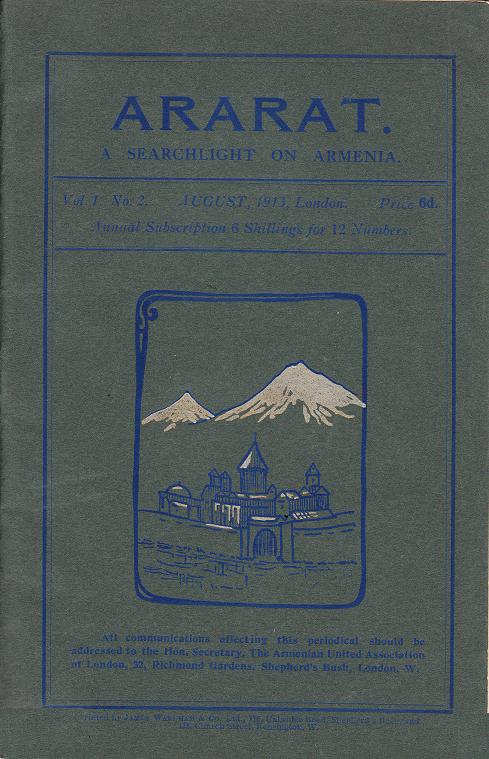 Rangement Rangement
Périodiques anglais
 | | Numéros disponibles : | Vol. 1, No 2, Augst 1913 |
|---|
| Sous-titre : | |
|---|
| Adresse : | 32, Richmond Gardens, Sheperd's Bush, London, W |
|---|
| Téléphone : | |
|---|
| Auteur : | The Armenian united association of London |
|---|
| Périodicité : | Mensuel |
|---|
| Abonnement : | Annual subscription 6 shillings for 12 Numbers |
|---|
| Début : | 1913 |
|---|
| Fin : | |
|---|
| Imprimeur : | James Wakeham and Co, Kensington W |
|---|
| Description : | 13,5 x 21 cm, 36 pages (pagination en série dans l'année) |
|---|
| ISSN : | |
|---|
| Comm. paritaire : | |
|---|
| Site : | |
|---|
| E-mail : | |
|---|
| Commentaire : | |
|---|
| Mise à jour : | 2013 |
|---|
|
Aregak - Armenian monthly - ԱՐԵԳԱԿ | 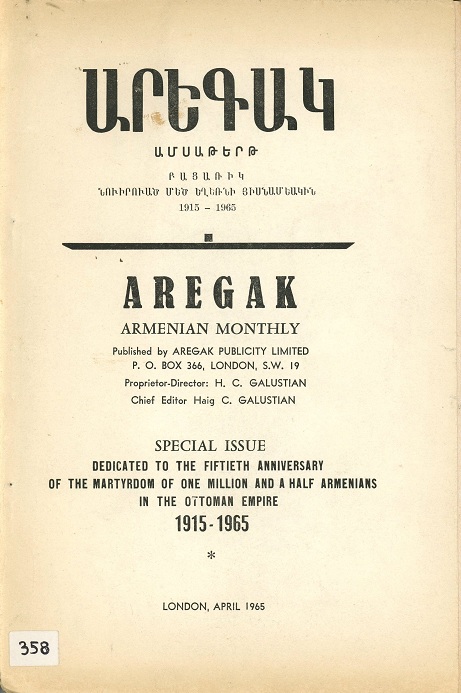 Rangement Rangement
Périodiques anglais
 | | Numéros disponibles : | Special issue 1965 |
|---|
| Sous-titre : | SPECIAL ISSUE DEDICATED TO THE FIFTIETH ANNIVERSARY OF THE MARTYRDOM OF ONE MILLION AND A HALF ARMEN |
|---|
| Adresse : | AREGAK PUBLICITY LIMITED P. O. BOX 366, LONDON, S.W. 19 |
|---|
| Téléphone : | |
|---|
| Auteur : | |
|---|
| Périodicité : | Annuel |
|---|
| Abonnement : | |
|---|
| Début : | |
|---|
| Fin : | |
|---|
| Imprimeur : | Printed in France |
|---|
| Description : | |
|---|
| ISSN : | |
|---|
| Comm. paritaire : | |
|---|
| Site : | |
|---|
| E-mail : | |
|---|
| Commentaire : | ARMENIAN MONTHLY
Published by AREGAK PUBLICITY LIMITED P. O. BOX 366, LONDON, S.W. 19
Proprietor. Director: H. C. GALUSTIAN
Chief Editor Haig C. GALUSTIAN |
|---|
| Mise à jour : | 2012 |
|---|
|
Armenian affairs | 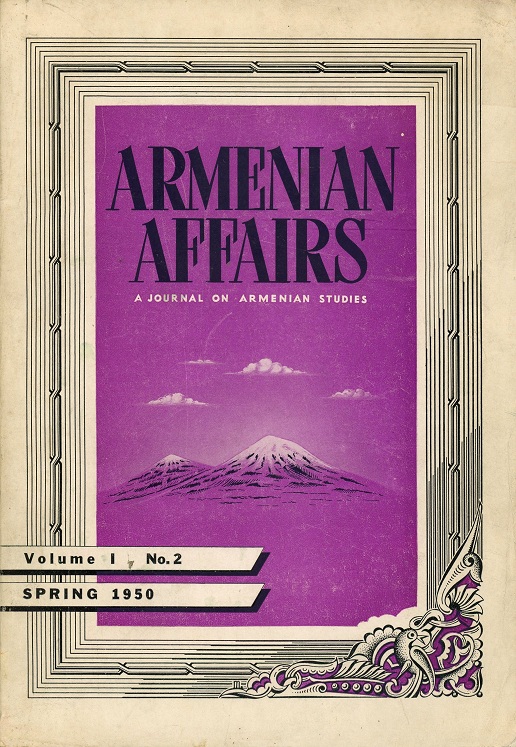 Rangement Rangement
Périodiques anglais
 | | Numéros disponibles : | Vol I, no 2 (Spring), nos 3-4 (Summer-Fall) |
|---|
| Sous-titre : | A journal on Armenian studies |
|---|
| Adresse : | 144 E 24th Street, New York 10, N. Y. |
|---|
| Téléphone : | |
|---|
| Auteur : | Editor : Charles A. Vartanes, Armenian national Council of America |
|---|
| Périodicité : | Trimestriel |
|---|
| Abonnement : | per Year : $ 5.00 |
|---|
| Début : | 1950 |
|---|
| Fin : | 1950 |
|---|
| Imprimeur : | |
|---|
| Description : | 18 x 25,5 cm, 228 pages, couverture illustrée en couleurs |
|---|
| ISSN : | |
|---|
| Comm. paritaire : | |
|---|
| Site : | |
|---|
| E-mail : | |
|---|
| Commentaire : | Le numéro 2 (1950) contient un article de Sérovpé Manoikian, "Dean of the Armenian Seminary in Jerusalem", à propos du Patriarcat arménien de Jerusalem (photos, etc.)
Spring, 1950 Vol. I, No. 2
TABLE OF CONTENTS
Appeal of Georg VI [130]
Frontispiece—• »
Georg VI, Catholicos and Patriarch of All the Armenians [1311
Cyril II, late Patriarch of Jerusalem . . [1321
Alice Stone Blackwell, Friend of the Armenian People [1331
Banquet in Honor of Alice Stone Blackwell, 1903 [1341
Alice Stone Blackwell—A Symposium .............CHARLES A. VERTANES 135
A Biographical Sketch ..........................MAUD WOOD PARK
Relations with Armenians ....M. C. GISMEGIAN
Interest in Armenia's Political Destiny ........................................................................
A Tribute ..................................................SAMUEL A. ELIOT
A Sonnet..................................................................WILLIAM LLOYD GARRISON, JR.
Armenians As I Have Known Them............ALICE STONE BLACKWELL
The Lake of Van (Poem) .RAFFI
Notes on the Evolution of Armenia's Architecture..................VAHAN HAGOPIAN 151
Literary Pilgrimages to Armenia
From America to Armenia....................................................................................K. SITAL 159
From Moscow to Yerevan .....................................................................A. ARSHARUNI 166
A Brief Sketch of Armenian History .VAZKENE AYKOUNI 176
Briefs
The Comedy of Life — "Uucle Geer".......................................G. EKSOOZIAN 185
Tribute to Armenians .THOMAS A. SPARKS, S.T.D. 188
Theodore Roosevelt and Armenia .ASHAG MAHDESIAN 190
Reports
The Internationalization of Jerusalem and the Armenian Patriarchate ............ 193
Letter Regarding the New Jerusalem Plan . 197
Biographical Sketches
His Beatitude Cyril II, Arshag Mahdesian, Artak Darbinian, and Leon Guerdan .A. MELIKSETIAN 199
Book Reviews
Country Without Economic Backbone .EMIL LENGYEL 206
The Armenian Question in Paris in 1919 .C. P. IvES
Letters to the Editor 210
Documents
Testimony of the Armenian National Council on Genocide 215
Bibliography 223
Books Received 227
Illustrated Supplement [229]
The Armenian Patriarchate of Jerusalem SEROVPE VARDAPET MANOUKIAN |
|---|
| Mise à jour : | 2012 |
|---|
|
Armenian Forum | 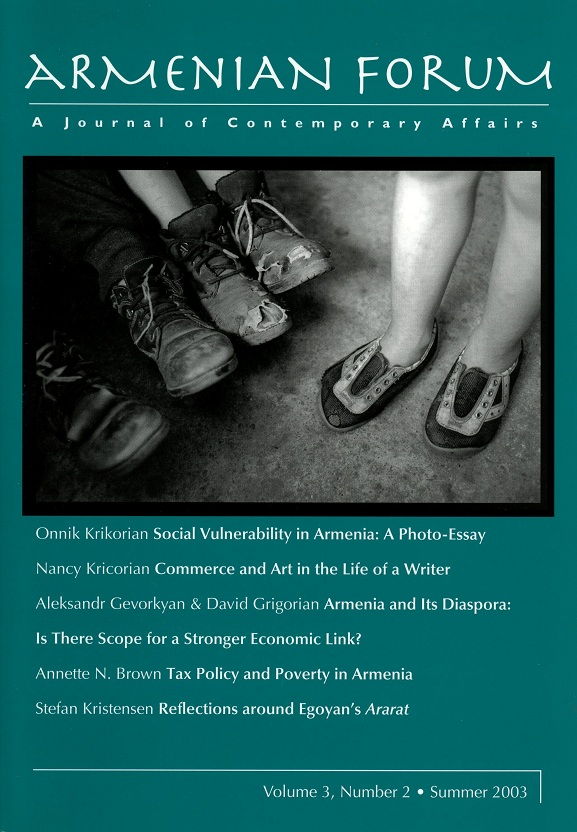 Rangement Rangement
Périodiques anglais
 | | Numéros disponibles : | Tous numéros parus |
|---|
| Sous-titre : | A Journal of Cntemporary Affairs |
|---|
| Adresse : | 42 Blythe Rd, London W14 0HA, England |
|---|
| Téléphone : | |
|---|
| Auteur : | Gomidas Intitute |
|---|
| Périodicité : | Trimestriel |
|---|
| Abonnement : | US $ 34.00 |
|---|
| Début : | 1998 |
|---|
| Fin : | 2003 |
|---|
| Imprimeur : | |
|---|
| Description : | 17 x 25 cm, 120 pages, couverture illustrée en couleurs |
|---|
| ISSN : | 1091-4714 |
|---|
| Comm. paritaire : | |
|---|
| Site : | www.gomidas.org/forum/welcome.htm |
|---|
| E-mail : | |
|---|
| Commentaire : | FROM ECONOMICS TO PUBLIC HEALTH, from law to education, specialists increasingly are choosing Armenians and Armenia as a focus of study. Armenian Forum gives them a place to report their findings. It allows them to share their research with each other and with the educated nonspecialist. The journal serves as a resource for scholars, journalists, policy makers and the public at large.
A bold, contemporary look, thought-provoking articles, and reviews of books, recordings, and films are among the journal’s compelling features. Armenian Forum addresses the interests of a new generation that is eager for fresh, thoughtful perspectives as it fashions its own identity.
Armenian Forum promises to be an essential building block for the Armenian communities of the twenty-first century. |
|---|
| Mise à jour : | 2011 |
|---|
|
Armenian Institute News - ՀԱՅ ՀԻՄՆԱՐԿ | 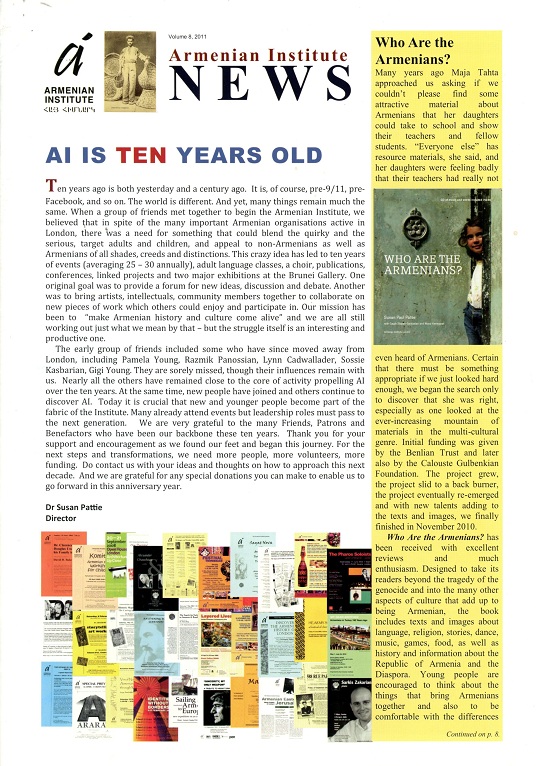 Rangement Rangement
Périodiques anglais
 | | Numéros disponibles : | Volume 7 (2009), Volume 8 (2011) |
|---|
| Sous-titre : | |
|---|
| Adresse : | 7 Hollingbourne Road London, Se24 9NB |
|---|
| Téléphone : | 020 7978 9104 |
|---|
| Auteur : | Susan Pattie, Gagik Stepan-Sarkissan |
|---|
| Périodicité : | Annuel |
|---|
| Abonnement : | |
|---|
| Début : | 2009 |
|---|
| Fin : | 2011 |
|---|
| Imprimeur : | |
|---|
| Description : | 21 x 29,7 cm, 16 pages, couverture illustrée en couleurs |
|---|
| ISSN : | |
|---|
| Comm. paritaire : | |
|---|
| Site : | |
|---|
| E-mail : | |
|---|
| Commentaire : | |
|---|
| Mise à jour : | 2012 |
|---|
|
Armenian Review | 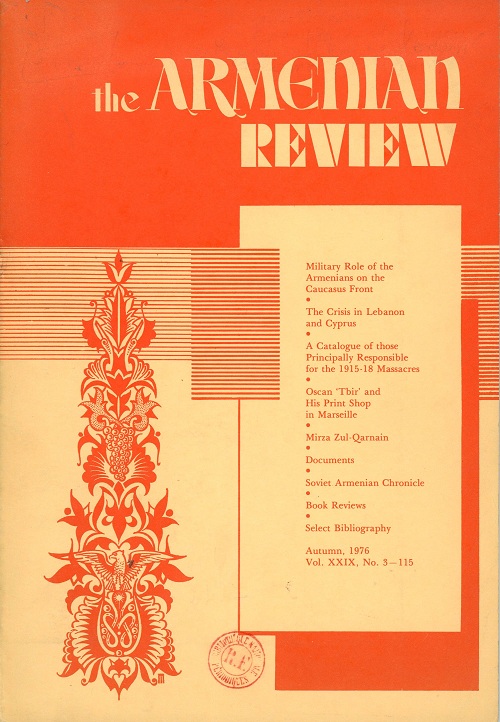 Rangement Rangement
Périodiques anglais
 | | Numéros disponibles : | Année 1976 (vol 29) : 3-115
Année 1976 (vol 38) : 3
Année 185 (vol 38) : 4
Année 1986 : 1, 2, 3, 4
Année 1987 (vol 40) : 1-157, 2-158
Année 1989 (vol 42) : 1-165 |
|---|
| Sous-titre : | |
|---|
| Adresse : | 80 Bigelow Ave., Watertown, Mass 02172 |
|---|
| Téléphone : | |
|---|
| Auteur : | Editor : Tatul Sonentz-Papazian |
|---|
| Périodicité : | Mensuel |
|---|
| Abonnement : | Year : $ 15.00 |
|---|
| Début : | 1976 |
|---|
| Fin : | 1989 |
|---|
| Imprimeur : | Kirkwood Tchnical ublicatiosn, Inc., Wilmington, MA |
|---|
| Description : | 17 x 24,5 cm, 80 pages, couverture illustrée en couleurs |
|---|
| ISSN : | 0004-2356 |
|---|
| Comm. paritaire : | |
|---|
| Site : | |
|---|
| E-mail : | |
|---|
| Commentaire : | TABLE OF CONTENTS
Military Role of the Armenians on the Caucasian Front After the Defection of the Russian Army........A. Poidebard 227
The Crisis in Lebanon and Cyprus: Background........Puzant Yeghiayan 243
A Catalogue of Those Principally Responsible for the 1915-18 Massacres...........Haigazn Kazarian 253
Oscan 'Tbir' and His Print Shop in Marseille.............................Charles Diran Tekeian 273
The Reform Movement in Turkey: Background.........LillianEtmekjian 281
Mirza Zul-Qarnain: An Armenian Grandee at the Mogul Court (Part I) ..................MesrovbJacob Seth 293
DOCUMENTS
Continuation of British Papers ............................ 316
SOVIET ARMENIAN CHRONICLE................................ 324
BOOK REVIEWS ................................................ 326
A SELECT BIBLIOGRAPHY OF PERIODICAL LITERATURE.................Levon Saryan 334 |
|---|
| Mise à jour : | 2019 |
|---|
|
Armenian Voice - Newsletter for the London-Armenian Community | 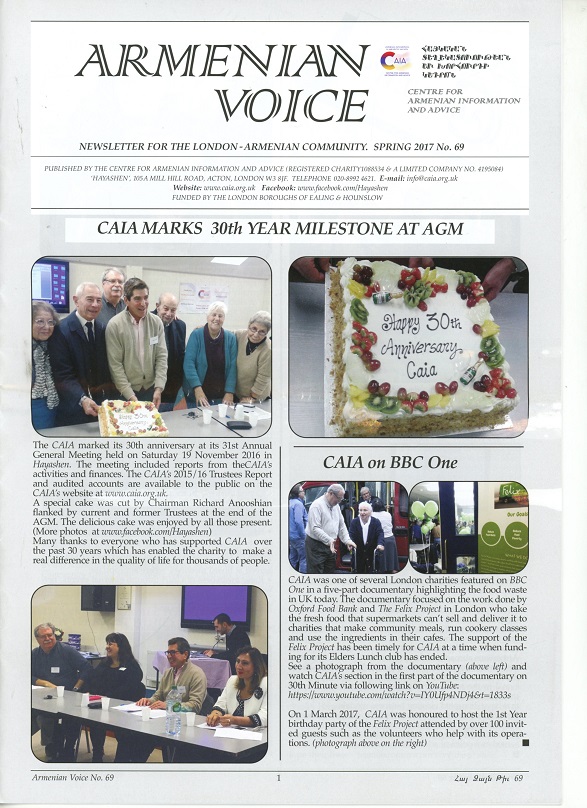 Rangement Rangement
Périodiques anglais
 | | Numéros disponibles : | Année 2006 : numéro spécial commémoratif (Twenty years at the heart of the community)
Année 2009 : numéro 56
Année 2013 : numéros 61, 62
Année 2014 : numéros 63, 64
Année 2015 : numéro 66
Année 2016 : numéros 67, 68
Année 2017 : numéros 69, 70
Année 2018 : numéro 71
Année 2019 : numéro 72
Année 2020 : numéro 73
Année 2021 : numéro 74
Année 2023 : numéro 76 |
|---|
| Sous-titre : | |
|---|
| Adresse : | "Hayashen", 105A Mill Hill Road, Acton, London W3 8JF |
|---|
| Téléphone : | |
|---|
| Auteur : | Centre for Armenian information and advice |
|---|
| Périodicité : | Trimestriel |
|---|
| Abonnement : | |
|---|
| Début : | 2014 |
|---|
| Fin : | |
|---|
| Imprimeur : | |
|---|
| Description : | 21 x 29 cm, 16 pages illustrations en couleurs |
|---|
| ISSN : | |
|---|
| Comm. paritaire : | |
|---|
| Site : | caia.org.uk |
|---|
| E-mail : | |
|---|
| Commentaire : | |
|---|
| Mise à jour : | 2024 |
|---|
|
BBardez | 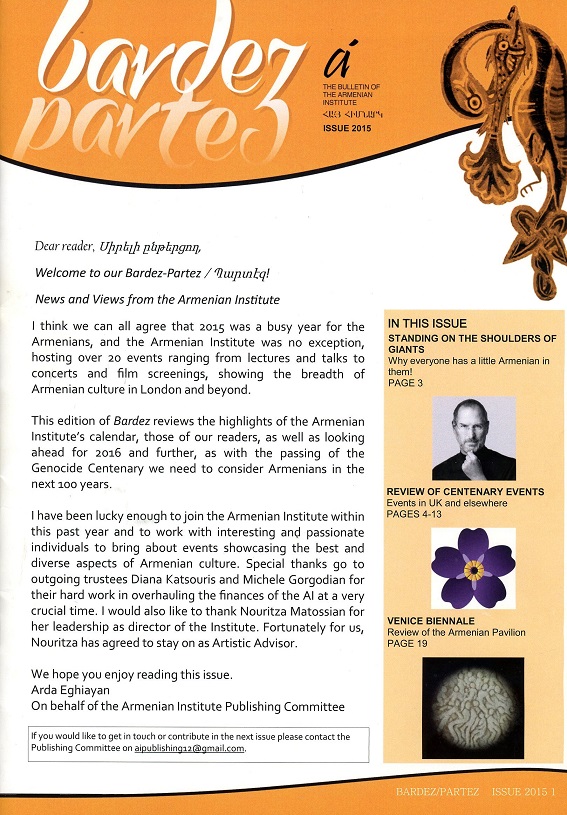 Rangement Rangement
Périodiques anglais
 | | Numéros disponibles : | Issue 2015 |
|---|
| Sous-titre : | The Bulletin of the Armenian Institute |
|---|
| Adresse : | Armenian Church Hall - Iverna Gardens - London W8 6TP |
|---|
| Téléphone : | 020 7938 3336 |
|---|
| Auteur : | Armenian Institute |
|---|
| Périodicité : | Annuel |
|---|
| Abonnement : | |
|---|
| Début : | 2015 |
|---|
| Fin : | |
|---|
| Imprimeur : | |
|---|
| Description : | 21 x 29 cm, 24 pages, photographies en couleur |
|---|
| ISSN : | |
|---|
| Comm. paritaire : | |
|---|
| Site : | |
|---|
| E-mail : | |
|---|
| Commentaire : | |
|---|
| Mise à jour : | 2016 |
|---|
|
CCanada Armenian Press | 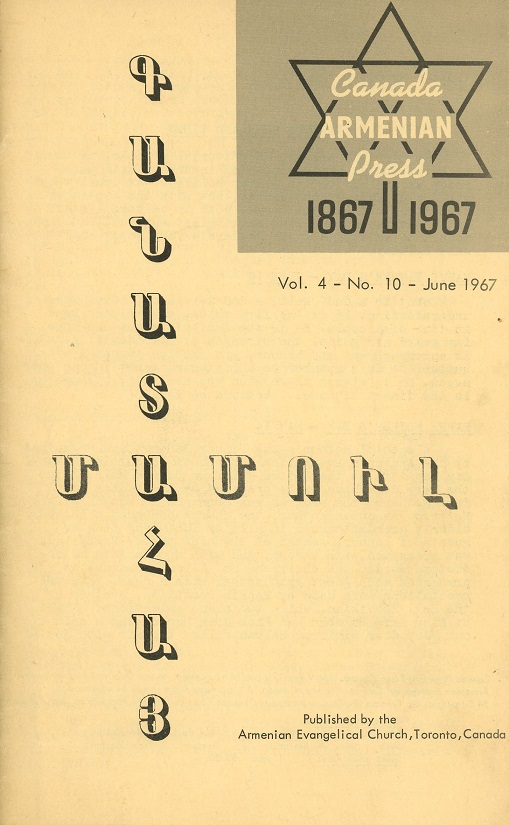 Rangement Rangement
Périodiques anglais
 | | Numéros disponibles : | Année 1967 (volume 4) : numéro 10 ; Année 1967 (volume 5) : numéro 1, 2, 3 ,4 |
|---|
| Sous-titre : | Գանատահայ մամուլ |
|---|
| Adresse : | 34 Glenforest Rd - Torionto 12 - Ontario |
|---|
| Téléphone : | |
|---|
| Auteur : | Armenian Evangelical Church Toronto |
|---|
| Périodicité : | Mensuel |
|---|
| Abonnement : | 1 year $ 3.00 |
|---|
| Début : | 1967 |
|---|
| Fin : | |
|---|
| Imprimeur : | |
|---|
| Description : | 14 x 21,5 cm, 16 page |
|---|
| ISSN : | |
|---|
| Comm. paritaire : | |
|---|
| Site : | |
|---|
| E-mail : | |
|---|
| Commentaire : | |
|---|
| Mise à jour : | 2018 |
|---|
|
DDiaspora | 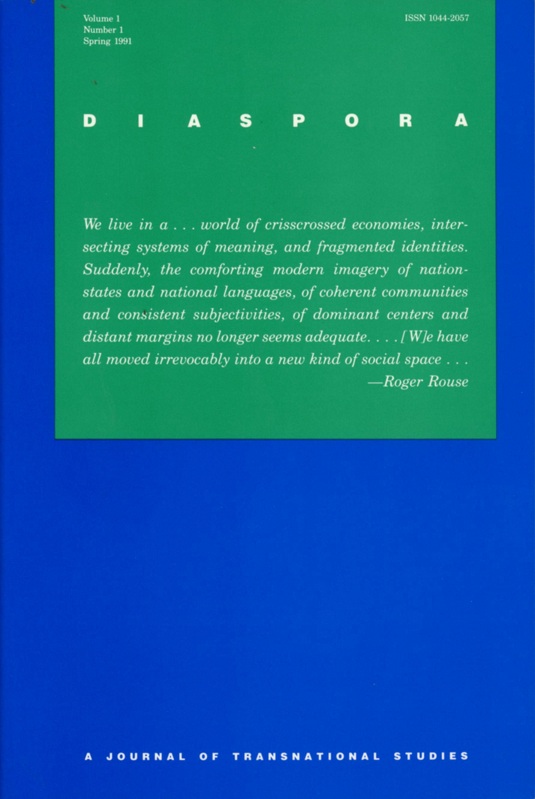 Rangement Rangement
Périodiques anglais
 | | Numéros disponibles : | 1991 : volume 1, number 1, Spring 1991 |
|---|
| Sous-titre : | A journal of transnational studies |
|---|
| Adresse : | 200 Madison Ave. New York, NY 10016 |
|---|
| Téléphone : | |
|---|
| Auteur : | Oxford University Presse |
|---|
| Périodicité : | Trimestriel |
|---|
| Abonnement : | |
|---|
| Début : | 1991 |
|---|
| Fin : | |
|---|
| Imprimeur : | |
|---|
| Description : | 15,5 x 23 cm, 128 pages |
|---|
| ISSN : | 1044-2057 |
|---|
| Comm. paritaire : | |
|---|
| Site : | |
|---|
| E-mail : | |
|---|
| Commentaire : | Sponsored by the Zoryan Institute of Cambridge, MA.
ISBN 0-19-507081-X
1 In This Issue
3 The Nation-State and Its Others: In Lieu of a Preface Khachig Tololyan
8 Mexican Migration and the Social Space of Postmodernism Roger Rouse
24 Heterogeneity, Hybridity, Multiplicity: Marking Asian American Differences Lisa Lowe
45 Italians in Australia: Building a Multicultural Society on the Pacific Rim Stephen Castles
67 Anticipating Nationhood: Collaboration and Rumor in the Japanese Occupation of Manila Vicente L. Rafael
83 Diasporas in Modern Societies: Myths of Homeland and Return William Safran
100 The Jewish Community of Salonika: The End of a Long History Anthony Molho
123 Notes on Contributors |
|---|
| Mise à jour : | 2012 |
|---|
|
GGenocide studies and prevention | 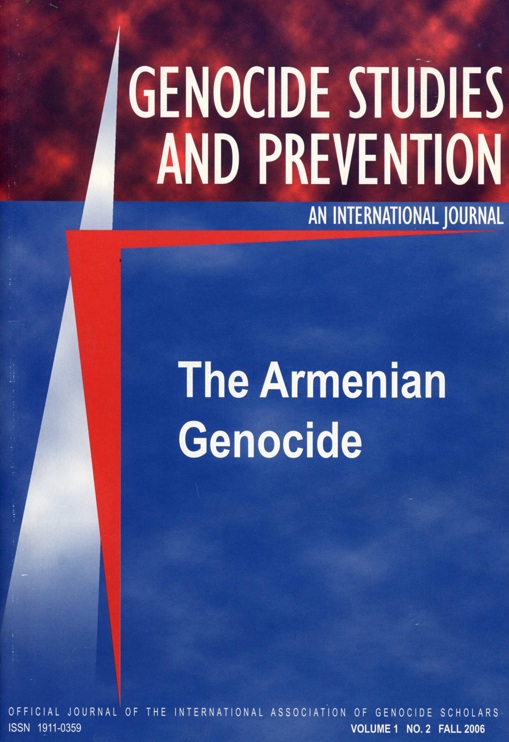 Rangement Rangement
Périodiques anglais
 | | Numéros disponibles : | Volume 1, No 2, Fall 2006 |
|---|
| Sous-titre : | An international journal |
|---|
| Adresse : | Virginia Commonwealth University, Richmond VA 23284, USA |
|---|
| Téléphone : | |
|---|
| Auteur : | International association of genocide scolars |
|---|
| Périodicité : | Mensuel |
|---|
| Abonnement : | |
|---|
| Début : | 2006 |
|---|
| Fin : | |
|---|
| Imprimeur : | |
|---|
| Description : | 18 x 25 cm, 140 pages (pagination en série) |
|---|
| ISSN : | 1911-0359 |
|---|
| Comm. paritaire : | |
|---|
| Site : | |
|---|
| E-mail : | |
|---|
| Commentaire : | The Significance of the Armenian Genocide after Ninety Years
Roger W. Smith
Each genocide provides a foundation for subsequent horrors. Each historical misrepresentation of efforts to exterminate a particular ethnic group increases the likelihood th;it such efforts will be undertaken again in another time and place.
That over one million Armenian men, women, and children could have been subjected to genocide by the Young Turk government in 1915 and that the world for many years would not remember is profoundly disturbing. Not to remember the suffering of the victims is, above all, a failure of humanity and compassion on our part—a lack of respect and care for fellow humans who have fallen victim to the ultimate outrage against justice, the death of a people. We do not ordinarily think of the dead as having rights, but there is at least one they possess: the right to have the world " Hear and learn the truth about the circumstances of their death." This is the one right that, ninety years later, can still be restored to them, and surely we can do no less.
But genocide is not only a crime against a particular people; it is also a crime against humankind. Its inherent potential is to distort and alter the very meaning of "humankind," erasing for all time particular biological and cultural possibilities. Furthermore, for a particular group to claim for itself a right to determine what groups are, in effect, human, possessing the right to life, is a threat to the existence of all other humans. In a period in which genocide has claimed an enormous number of victims, with no end to the carnage in sight, the prevention of future acts of genocide becomes a task for all human beings and governments throughout the world.
Yet without remembrance of past examples of genocide, there will be no sense of urgency in the present, no perceived need to prevent future atrocities. Further, we will cut ourselves off from the knowledge of the causes and sequences of genocide, knowledge that might help prevent other peoples from being subjected to this crime against humanity. The Armenian Genocide is particularly instructive in that it is the prototype for much of the genocide in the twentieth century and the new millennium.
However, when governments look the other way or actively cover up genocide out of short-term self-interest, a signal is sent to would-be perpetrators that they can resolve political and social issues through massive destruction without danger of outside intervention and, through a continual denial of the atrocities, can expect the world to forget these events entirely. Not remembering is not a neutral act—not to remember is to side with the executioners of whole groups and peoples.
The Armenian Genocide, in fact, illuminates with special clarity the dangers inherent in the political manipulation of truth through distortion, denial, intimidation, and economic blackmail. In no other instance has a government gone to such extreme lengths to deny that a massive genocide took place. That democratic governments (the United States and Israel) have supported Turkey in that effort raises significant questions about governmental accountability and the role of citizenship in a world in which truth increasingly comes in two forms—"official" and "alleged."
Finally, by helping us to recognize genocide for the radical evil it is, the Armenian example makes possible a transformation of consciousness, one that rejects every manifestation of genocide, including denial, as an instrument of state policy.
Rulers in an earlier age boasted of their annihilation of whole peoples and erected monuments to commemorate their deeds. More recently, however, denial of genocide has become the universal strategy of perpetrators. Those who initiate, or otherwise participate in, genocide typically deny that the events took place, that they bear any responsibility for the destruction, or that the term "genocide" is applicable to what occurred. Denial, unchecked, turns politically- imposed death into a "non-event": in place of words of recognition, indignation, and compassion, there is, with time, only silence. But denial can enter into the very fabric of a society, so that those who come after sustain and even intensify the denial begun by the perpetrators. The most strident and elaborate denial of genocide in history follows this pattern. The Turkish Republic, established in 1923, may not be guilty of physical genocide against Armenians, but it continues today to deny that the Young Turk government engaged in massive destruction of Armenians from 1915 to 1918, resulting in the death of over one million persons and in the elimination of the Armenian people from its homeland of nearly 3,000 years.
Turkey, of course, has also made special efforts in recent years to recognize the Jewish Holocaust and to show compassion for its victims. Yet it has gone to extraordinary lengths to prevent Jews from learning about the Armenian Genocide. The tactic of appealing to moral sentiment, self-interest, and fear has not been without some effect, but Jews might well be suspicious of overtures by a government that is engaged in the massive fabrication of history while the Holocaust itself is being subjected to major distortions and, among "revisionists," its very existence is denied.
Turkey's goal, however, is to prevent recognition of the fact that what was done to the Jews and what was done to the Armenians belong to a common category: genocide. It is especially important for Turkey to stifle this awareness among Jews because for victims of Nazism to state publicly that Armenians and Jews alike have been subjected to genocide carries a kind of moral persuasiveness that non-victims may lack, a power to authenticate the common victimage.
The distortion of history for political ends has significant implications for both the practice of democracy and the protection of human rights. Whatever else democracy means, it means that the government is accountable to the public. But if a government lies to its citizens, acquiesces in the intimidation of scholarship, suppresses freedom of speech, and tolerates attempts by the successor state to control what is taught in public schools, we have entered an Orwellian world where power dictates reality: truth is simply what the government says it is. Under these conditions, accountability is, at best, a fiction—a subversion of democracy on behalf of a regime unwilling to confront its country's past and accept its responsibilities in the present
Unless genocide is seen as a serious problem, no action will be taken to prevent it. And if previous examples of genocide are consigned to oblivion, the problem of prevention (a complicated and difficult task at best* will lack urgency—distraction, narrow conceptions of interest, and a politics that is blind to the fate of others will take over. Oblivion, however, contributes neither to the role of "innocent bystander" nor to neutrality: if one forgets the atrocities against the Armenians, the Cambodians, the people of East Timor, and others, one is, in effect, rewarding those who have managed successfully to use genocide as an instrument of state policy. Oblivion not only reduces the incentive to action, it cuts us off from the very knowledge that might help us to anticipate genocidal situations and to act before the destruction of life begins. If we were aware of the history of genocide in the past ninety years, we might be led to ask, for a range of cases, How did this genocide begin? What were its warning signs? What was the sequence of events? How might this genocide have been prevented or, once in progress, stopped?
The Armenian Genocide is instructive with respect to each of these issues: the question of political will, the reward for successful genocide, and the extraction of useful knowledge from the study of crimes against a subject population. Had the international community focused more on the Armenian case, more active steps to prevent genocide might have been taken. On the other hand, would-be perpetrators of genocide have seen what has happened with the Armenians: they think they can commit genocide and get away with it, and, through denial, eventually erase any recollection of their crime. And by ignoring the Armenian Genocide, we have lost, for too long, knowledge important to the prevention of genocide. No one, including the Jews, foresaw the Holocaust, yet the signs now look inescapable; when mounting evidence of mass death in extermination centers was presented to the Allies and to the media of the day, it simply was not believed. This, after all, was the twentieth century; no government would destroy a people en masse. But, of course, one already had—the trouble was that the Armenian tragedy had become, within only a few years, an "unremembered genocide."
Recognition and remembrance involve more than regard for truth: they express compassion for those who have suffered, respect for their dignity as persons, and revolt against the injustice done to them. In the deepest sense, recognition and remembrance are related not only to what happened but to questions of who we are, what society is, and how life and community can be protected against the visions that would destroy both.
Faced openly, the Armenian Genocide may lead not only to recognition and remembrance but to a deeper awareness of the nature of genocide. The accounts of suffering and brutality that are available to us, especially those of women and children in the caravans of death moving toward the Syrian desert, have the capacity to evoke in the least sentimental of us a sense of rage and shame at what human beings are capable of. From such accounts we gain knowledge that is both existential and cognitive, allowing us to recognize genocide as not only cruelty but radical evil.
In the next stage of awareness one realizes that genocide is a crime not only against a particular group but against humankind itself. Thus, out of solidarity with the victims and consciousness of the nature of genocide, one reaches a third stage in which mass murder as an instrument of state policy is rejected under any and all circumstances, whether attempted by one's own government or by those who have no claim to one's loyalty. The commitments of the third stage of consciousness have important consequences, for they imply that one must not lend support under any circumstances, including denial, to genocide. Further, one must attempt to prevent genocide where possible and, failing in that, must oppose it to the extent that one can. Where past genocides are denied, one has a responsibility to point out and correct such distortions of fact. Where physical genocide ceases but genocide continues at the cultural level, one must oppose it. Where reparation and restitution for past acts of genocide are rejected, one has an obligation to seek justice to the extent possible.
Faced openly, the Armenian Genocide can also provide knowledge that may assist directly in saving lives in the future. For the Armenian case is the prototype for much of the genocide that followed it, especially that arising from what genocide scholars refer to as the "plural society." These are societies characterized by sharp divisions between ethnic, racial, or religious groups; different degrees of power; and inequality of rights. In such societies, genocide is often resorted to when struggle breaks out over a demand, real or imaginary, for greater equality, partial autonomy, or complete separation. Analyzed from the perspective of a theory of pluralistic genocide, the Armenian example could be particularly suggestive about why a certain type of genocide (the most common form in recent history) occurs and how it might be prevented. In a little over a century in which state-sponsored mass murder has already claimed the lives of some sixty million human beings, the importance of this kind of inquiry speaks for itself.
Yet the scale and frequency of genocide since 1915 can make us feel that the task of prevention is futile. Despair stands in the way of action; knowledge leads to a sense of hopelessness. We cannot bring back to life the dead of the past century or those who have been victims of political mass murder throughout the ages, but, through courage as well as knowledge, we can act to bring about a world free from the scourge of mass killing. In committing ourselves to creating a world of peace, freedom, and mutual respect, we honor the memory of those who have fallen victim to the ultimate crime. |
|---|
| Mise à jour : | 2012 |
|---|
|
HHOOSHARAR (The Prompter) | 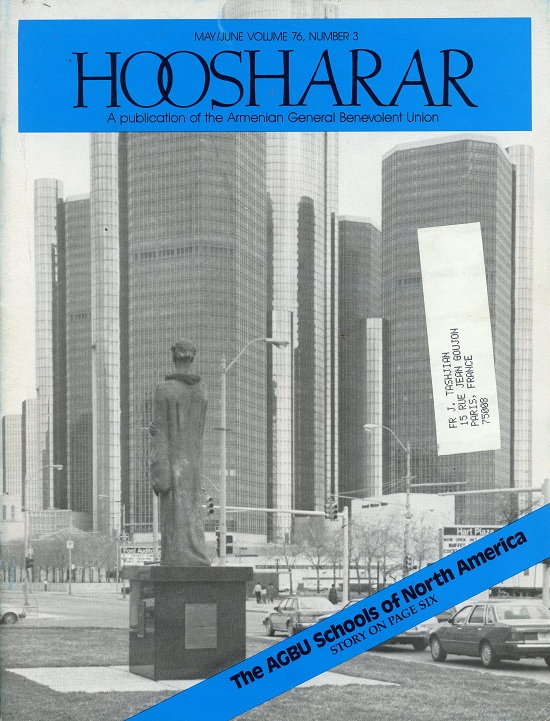 Rangement Rangement
Périodiques anglais
 | | Numéros disponibles : | Année 1939 : numéro 197, 200
Année 1947 : numéro
Année 1956 : volume 42, numéro 10, 14
Année 1960 (Vol 47) : nuémro 1Année 1970 : volume 57
Année 1979 : volume 66, numéro 1
Année 1984 : volume 3 (71), numéro 4
Année 1988, volume 76, numéro 3
Année 1994 : volume 81, numéro 4
Année 1995, volume 82, numéro 1, 2, 3,
Année 1996, volume 84, numéro 1, 2, 3, 4
Année 1996 : volume 85, numéro 1, 2, 3
Année 2000 : volume 88, numéro
Année 2005 : volume 93, numéro 1 |
|---|
| Sous-titre : | A publication of the Armenian Genral Benevolent Union |
|---|
| Adresse : | 585 Saddle River Road, Saddle Brook, N.J. 07662 |
|---|
| Téléphone : | |
|---|
| Auteur : | Armenian General Benevolent Union, Central Committe of América |
|---|
| Périodicité : | Bimestriel |
|---|
| Abonnement : | Subscriptions S10.00 per year |
|---|
| Début : | |
|---|
| Fin : | |
|---|
| Imprimeur : | |
|---|
| Description : | 22 x 28 cm, 24 pages, couverture illustrée1-201-797-7600 |
|---|
| ISSN : | |
|---|
| Comm. paritaire : | |
|---|
| Site : | |
|---|
| E-mail : | |
|---|
| Commentaire : | |
|---|
| Mise à jour : | 2021 |
|---|
|
Hye Sharzhoom - Armenian Action - ՀԱՅ ՇԱՐԺՈՒՄ | 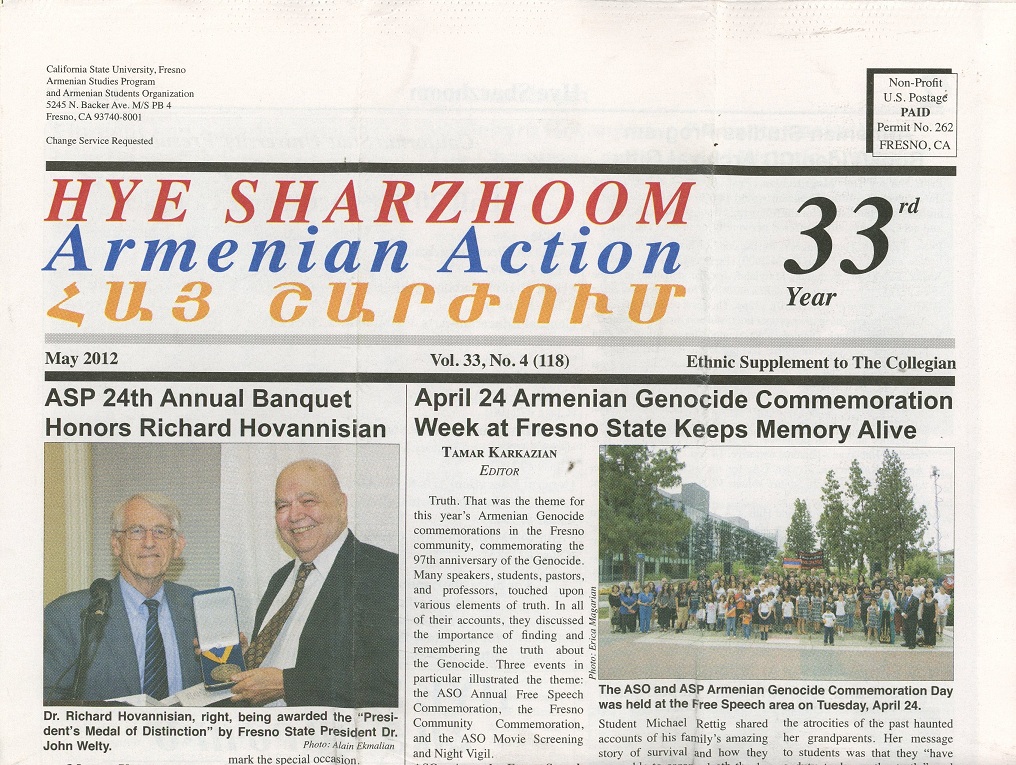 Rangement Rangement
Périodiques anglais
 | | Numéros disponibles : | Année 2008 (30e année) : numéro 104 ; Année 2009 : numéro 108 ; Année 2010 : numéros 109, 110, 111, 112, ; Année 2011 : numéros 115, 116, 118
Année 2020 : 150 |
|---|
| Sous-titre : | Ethnic Supplement to The Collegian |
|---|
| Adresse : | 5245 N. Backer Ave. M/S PB4, Fresno CA 937400-8001 |
|---|
| Téléphone : | (559) 278-2669 |
|---|
| Auteur : | California State University, Fresno Armenian Studies Program and Armenian Students Organization |
|---|
| Périodicité : | Mensuel |
|---|
| Abonnement : | |
|---|
| Début : | 1978 |
|---|
| Fin : | |
|---|
| Imprimeur : | |
|---|
| Description : | 29 x 42 cm, 8 pages, papier journal, photographies en coouleur |
|---|
| ISSN : | |
|---|
| Comm. paritaire : | |
|---|
| Site : | armenianstudies.csufresno.edu |
|---|
| E-mail : | |
|---|
| Commentaire : | Armenian Studies Program Faculty:
Barlow Der Mugrdechian, Coordinator, Armenian Studies Program and Director of the Center for Armenian Studies, ASO Advisor, Hye Sharzhoom Advisor (barlowd@csufresno.edu)
Sergio La Porta, Haig and Isabel Berberian Professor of Armenian Studies Dickran Kouymjian, Berberian Professor Emeritus of Armenian Studies |
|---|
| Mise à jour : | 2020 |
|---|
|
JJahagir - ՋԱՀԱԿԻՐ | 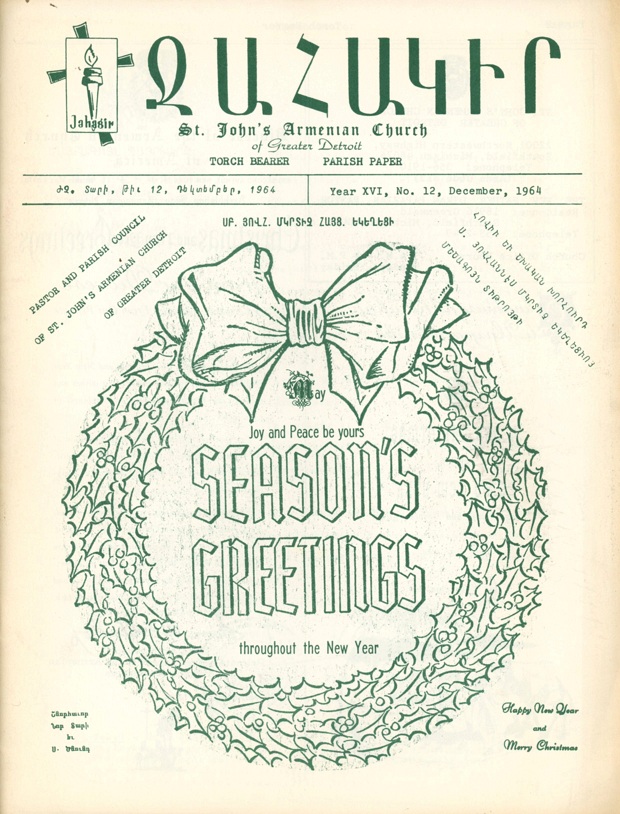 Rangement Rangement
Périodiques anglais
 | | Numéros disponibles : | Année 1964 (16e années), numéro 12 |
|---|
| Sous-titre : | |
|---|
| Adresse : | 22001 Northwestern Highway, Southfield, Michigan 48076 |
|---|
| Téléphone : | |
|---|
| Auteur : | St John's Armenian Church of Gretaer Detrot |
|---|
| Périodicité : | Mensuel |
|---|
| Abonnement : | |
|---|
| Début : | 1964 |
|---|
| Fin : | |
|---|
| Imprimeur : | |
|---|
| Description : | 21,5 x 28 cm, 24 pages |
|---|
| ISSN : | |
|---|
| Comm. paritaire : | |
|---|
| Site : | |
|---|
| E-mail : | |
|---|
| Commentaire : | Parish paper TORCHBEARER EDITORIAL STAFF
Editor-in-Chief: THE REV. FR. DIRAN PAPAZIAN
Editor: Yeretzgin Rosalie Papazian
Assistants to the Editor: Mrs. Helen Armoudlian Mrs. Margo Hatcherian
REPORTERS
Miss Elizabeth Aprahamian ACYOA, SRS.
Miss Elizabeth Aprahamian CHURCH SCHOOL
Mrs. Agnes Carman WOMEN'S GUILD
Mr. Ardavazt Ekizian CHOIR
Mrs. Lillian Hovsepian P.T.A., CHURCH SCHOOL |
|---|
| Mise à jour : | 2012 |
|---|
|
Journal of Armenian studies | 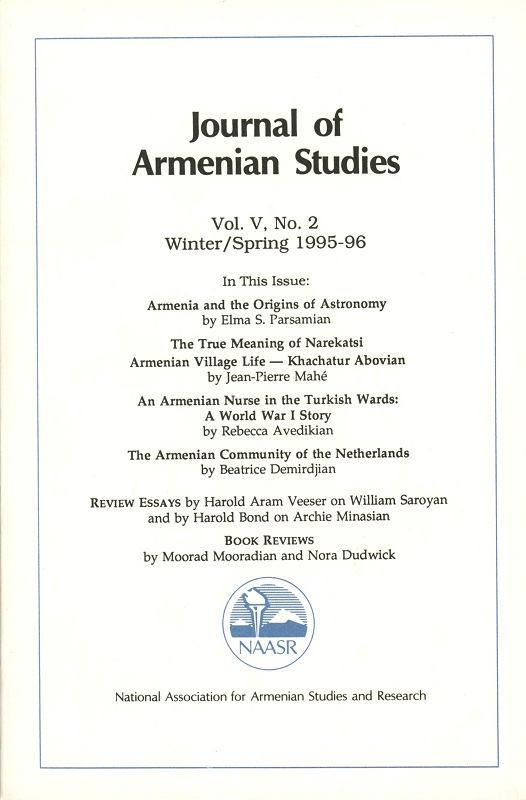 Rangement Rangement
Périodiques anglais
 | | Numéros disponibles : | Vol. I, No 1 (1975), Vol. II, No 2 (1985-1986), Vol. III, Nos 1 et 2 (1986-1987), Vol. V, No 1 (1990-91) |
|---|
| Sous-titre : | |
|---|
| Adresse : | National Association for Armenian Studies and Research, Inc. 395 Concord Avenue, Belmont, MA 02478 |
|---|
| Téléphone : | USA (617) 489-1610 |
|---|
| Auteur : | National Association for Armenian Studies and Research (NAASR) |
|---|
| Périodicité : | Mensuel |
|---|
| Abonnement : | $ 20 per year |
|---|
| Début : | 1975 |
|---|
| Fin : | 2004 |
|---|
| Imprimeur : | |
|---|
| Description : | 15 x 23 cm, 126 pages |
|---|
| ISSN : | |
|---|
| Comm. paritaire : | |
|---|
| Site : | |
|---|
| E-mail : | |
|---|
| Commentaire : | The Journal of Armenian Studies consists of scholarly and popular articles on Armenian history, culture, and related subjects. The Journal welcomes submissions and evaluates articles based on their merit rather than the credentials of the author or his or her institutional affiliation. |
|---|
| Mise à jour : | |
|---|
|
Journal of The Society for Armenian Studies | 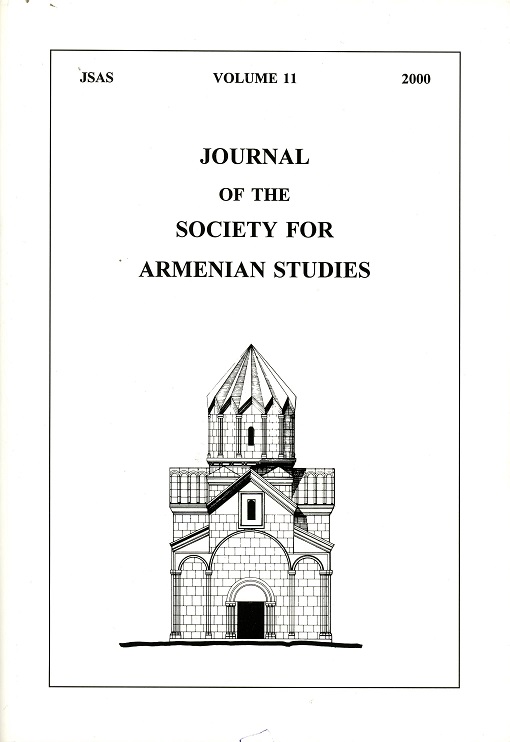 Rangement Rangement
Périodiques anglais
 | | Numéros disponibles : | Année 2000 (Volume 11)
Année 2010 (Volume 19) : nuémro 2 |
|---|
| Sous-titre : | |
|---|
| Adresse : | University of Michigan-Dearborn |
|---|
| Téléphone : | |
|---|
| Auteur : | Society for Armenian Studies |
|---|
| Périodicité : | Annuel |
|---|
| Abonnement : | |
|---|
| Début : | 200 |
|---|
| Fin : | |
|---|
| Imprimeur : | |
|---|
| Description : | 18 x 25 cm, 248 pages |
|---|
| ISSN : | 0747-9301 |
|---|
| Comm. paritaire : | |
|---|
| Site : | |
|---|
| E-mail : | |
|---|
| Commentaire : | In JSAS Volume 11
ARTICLES
James R. Russell, Ch 'arents' the Prophet. Tom Sinclair, The Economy of Armenia under the Il-Khans. Sarkis Y. Karayan, Vital Cuinet's La Turquie d'Asie: A Critical Evaluation of Cuinet's Information about Armenians. Artsvi Bakhchinyan, Armenian-Scandinavian Relations from the Early Middle Ages to the Eighteenth Century. Artsvi Bakhchinyan, Scandinavian-Armenian Bibliography. Nigoghos G. Tahmizyan, Gusan Art in Historic Armenia. Nadezhda Banchik, Armenians and Jews in Galicia: Toward a Project of Comparative Research.
STUDENT VOICES
Readings: The Forty Days of Musa Dagh.
REVIEW ESSAY
Virgil Strohmeyer, of Richard G. Hovannisian, ed., The History of the Armenian People from Ancient to Modern Times.
BOOK REVIEWS
(Titles Simplified)
Ghazarian, A Village Remembered. Mattern, Rome and the Enemy. Tuglaci, The Role of the Balian Family in Ottoman Architecture.
COMMUNICATIONS
Artsvi Bakhchinyan, Stig Wikander's Letter to Charles Vertanes. Arm en Ter-Stepanyan, New Material about the Mamikonean Family.
INDEXES
Gerald E. Ottenbreit, Jr., Index to the Journal of the Society for Armenian Studies 1-5. Gerald E. Ottenbreit, Jr., Index to the Journal of the Society for Armenian Studies 6-10
|
|---|
| Mise à jour : | 2017 |
|---|
|
KKeghard | 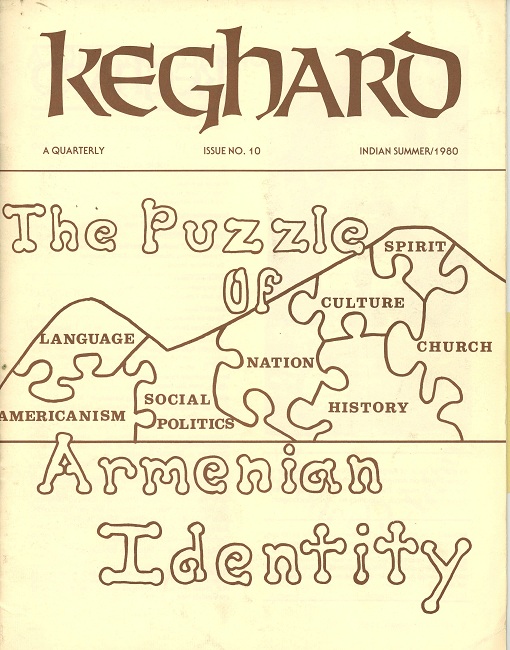 Rangement Rangement
Périodiques anglais
 | | Numéros disponibles : | Année 1960, Numéro 10, Indian Summer |
|---|
| Sous-titre : | |
|---|
| Adresse : | 34 Pe-quossette St., Watertown, MA 02172 |
|---|
| Téléphone : | |
|---|
| Auteur : | |
|---|
| Périodicité : | Trimestriel |
|---|
| Abonnement : | |
|---|
| Début : | 1960 |
|---|
| Fin : | |
|---|
| Imprimeur : | |
|---|
| Description : | 22 x 29 cm, 16 pages |
|---|
| ISSN : | 01945653 |
|---|
| Comm. paritaire : | |
|---|
| Site : | |
|---|
| E-mail : | |
|---|
| Commentaire : | KEGHARD (ISSN #01945653) is published quarterly for $4.00 per year by the Armenian Church Youth Organization of America (sponsored by the Diocese of the Armenian Church of America), 34 Pe-quossette St., Watertown, MA 02172. Second Class Postage is paid ot Boston, MA and at additional mailing offices. POSTMASTER: Send address changes to KEGHARD, 465 Mt. Auburn Street, Watertown, MA 02172. Editorial staff: Boston—Harry Alexanian, Robert Dor-zakian, Karnig H. Durgarian, Jr., Audrey Kalayjian, Judy Kelegian, James Magadan, Cynthia Seferian, Lisa Stepanian, Vaughn Totovian, Michael Yapchaian. New York—Elise Antreassian, Karen Sirabian. Advisor—Jack Antreassian. Coordinator—Michael Zeytoonian. Design & Layout — Elizabeth Sabounjian |
|---|
| Mise à jour : | 2012 |
|---|
|
Kroonk | 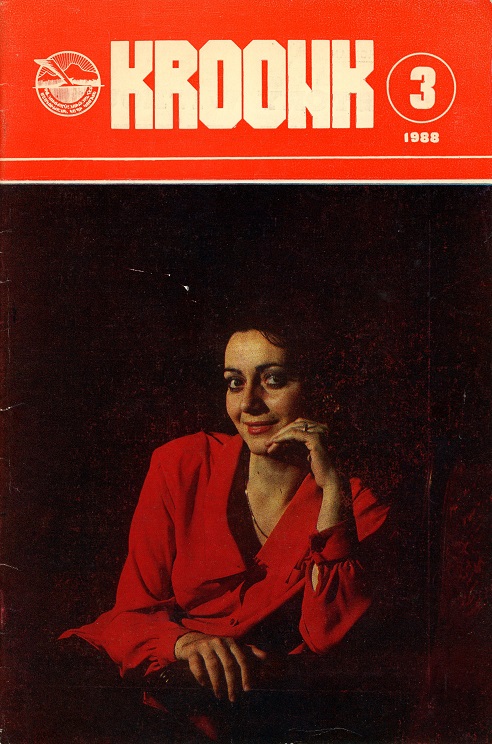 Rangement Rangement
Périodiques anglais
 | | Numéros disponibles : | Année 1982 : numéro 2
Année 1988 : numéro 3 |
|---|
| Sous-titre : | Digest of the Monthly " Sovetakan Hayastan " |
|---|
| Adresse : | Sovetakan Hayastan - 37, Alaverdian Street, Yerevan 10- Armenia , USSR |
|---|
| Téléphone : | |
|---|
| Auteur : | Committee for Cultural Relations with Armenians Abroad |
|---|
| Périodicité : | Mensuel |
|---|
| Abonnement : | |
|---|
| Début : | 1980 |
|---|
| Fin : | |
|---|
| Imprimeur : | |
|---|
| Description : | 17 x 25,5 cm, 32 pages, couverture illustrée en couleurs |
|---|
| ISSN : | |
|---|
| Comm. paritaire : | |
|---|
| Site : | |
|---|
| E-mail : | |
|---|
| Commentaire : | |
|---|
| Mise à jour : | 2021 |
|---|
|
LLooyce (ԼՈՅՍ) | 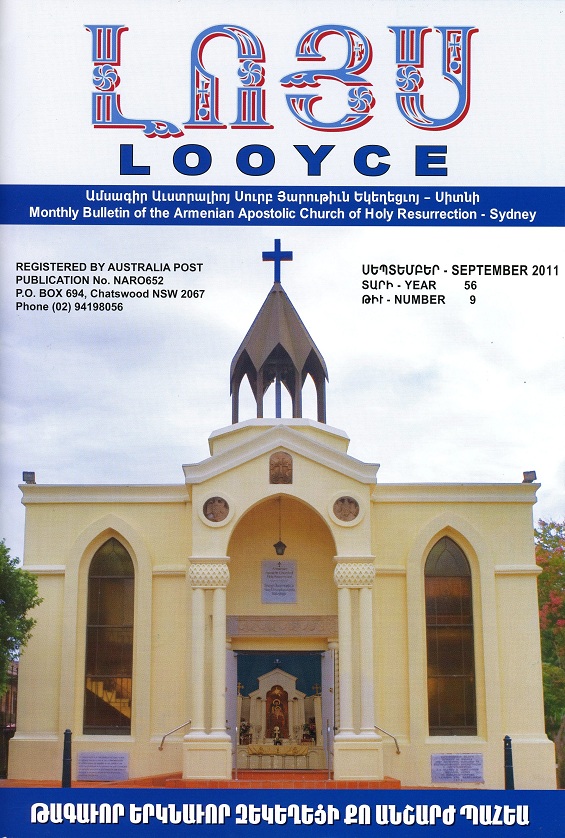 Rangement Rangement
Périodiques anglais
 | | Numéros disponibles : | 1983 : numéros 2, 3, 4, 6, 7, 9, 10, 11, 12
1984 : numéros 1, 2, 3, 4, 5, 6, 7, 8, 9, 10, 11, 12
1985 : numéros 1, 2, 3, 4, 5, 6, 7, 9, 10, 11, 12
1986 : numéros 1, 2, 3, 4, 5, 6, 7, 9, 11, 12
1987 : numéros 1, 2, 3, 4, 5, 6, 7, 8, 9, 10, 11, 12
1988 : numéros 1, 2, 4, 5, 6, 7, 8, 9, 10, 11
1989 : numéros 2, 3, 5, 7, 8, 10, 11
1990 : numéros 1, 2, 3, 4, 8, 9, 12
1991 : numéros 1, 2, 4, 5, 6, 7, 8, 9, 10, 12
1992 : numéros 1, 4, 7, 8, 9, 11, 12
1993 : numéros 1, 2, 4, 5, 6, 7, 8, 9, 10, 11, 12
1994 : numéros 1, 2, 3, 4, 5, 6, 7, 8, 9, 10, 11, 12
1995 : numéros 1, 2, 3, 5, 6, 7, 8, 9, 10, 11, 12
1996 (Year 41) : numéros 1, 2, 3, 4, 5, 7, 8, 9, 10, 11, 12
1997 : numéros 1, 2, 3, 4, 5, 6, 7, 8, 9, 10, 11, 12
1998 : numéros 1, 2, 3, 4, 5, 6, 7, 8, 9, 1011
2000 (Year 45), numéro : 1 à 7
2001 (Year 46), numéro : 1 à 6, 8 à 12
2002 (Year 47), numéro : 1 à 6, 8 à 12
2003 (Year 48), numéro : 1 à 12
2004 (Year 49), numéro : 1 à 12
2005 (Year 50), numéro : 1 à 12
2006 (Year 51), numéro : 1, 2, 4 à 12
2007 (Year 52), numéro : 1 à 11
2008 (Year 53), numéro : 1 à 9
2011 (Year 56), numéro : 5, 7 à 10
2012 (Year 57), numéro : 1 à 7, et numéro spécial « In memoriam of His Eminence Archbishop Aghan Baliozian, 9-10, 11-12
2013 (Year 58), numéro : 1 à 12
2014 (Year 59), numéro : 1, 3, 4, 6 à 12
2015 (Year 60), numéro : 1 à 5 |
|---|
| Sous-titre : | Monthly Bulletin of the Armenian Apostolic Church of Holy Resurrection - Sydney |
|---|
| Adresse : | PO Box 694, Chatswood NSW 2067 |
|---|
| Téléphone : | (02)094198056 |
|---|
| Auteur : | Armenian Apostolic Church of Holy Resurrection - Sydney |
|---|
| Périodicité : | Mensuel |
|---|
| Abonnement : | $45 (AUD) per annum |
|---|
| Début : | 1955 |
|---|
| Fin : | |
|---|
| Imprimeur : | |
|---|
| Description : | 21 x 29 xcm, 32 pages, cover color photo, bilingual publication |
|---|
| ISSN : | |
|---|
| Comm. paritaire : | |
|---|
| Site : | www.armenianchurchsydney.org.au |
|---|
| E-mail : | |
|---|
| Commentaire : | The monthly bulletin of the Church of Holy Resurrection is titled Looyce which means light or enlightenment. Looyce was first published in 1955 and continues today with the same purpose of reaching out to its parishioners.
The bilingual publication encompasses spiritual messages, scriptural teachings, church and diocesan news, local and overseas reports, articles of interest and local church events.
The current national subscription rate for Looyce is $45 (AUD) per annum.
Subscription enquiries can be made with the church office. |
|---|
| Mise à jour : | 2018 |
|---|
|
NNarrec | 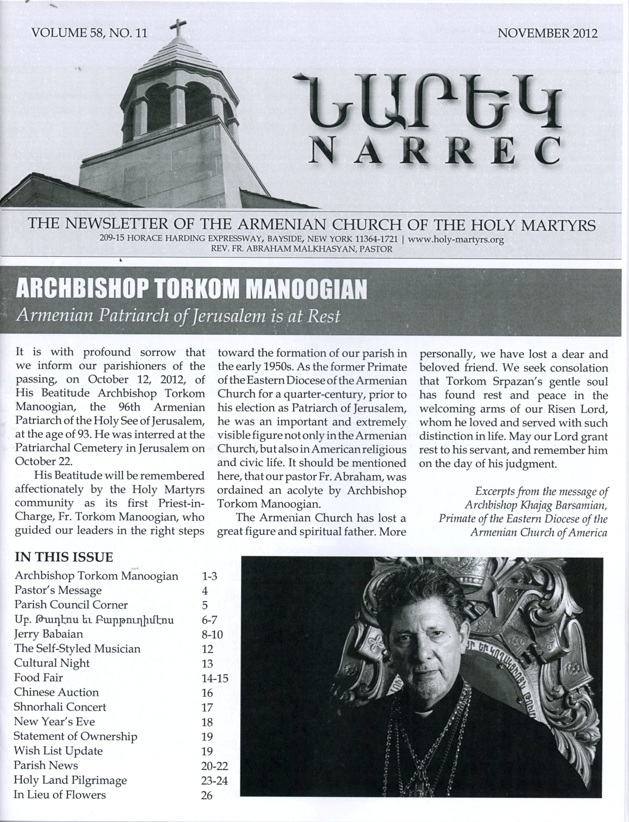 Rangement Rangement
Périodiques anglais
 | | Numéros disponibles : | Année 2001 (volume 47) : numéros 9 à 12
Année 2002 : 1 à 12
Année 2003 : 1, 2, 3, 6 à 12
Année 2004 : 1 à 12
Année 2005 : 1 à 12
Année 2006 : 1 à 9, 11, 12 (manque 10)
Année 2007 : 1 à 4, 6 à 12 (manque 5)
Année 2008 : 1 à 12
Année 2009 : 5, 8, 10
Année 2010 : manque
Année 20011 : 3, 5, 9, 10, 12
Année 2012 : 6, 10, 11
Année 2013 : 1, 2, 12
Année 2014 : numéro 2
Année 2015 : numéros 3, 6, 8, 9, 10 à 12
Année 2016 : numéros 1, 2, 4, 5, 6, 8, 9
Année 2017 : numéros 2, 3, 6, 7, 8, 9, 10, 11, 12
Année 2018 : numéros 1, 2, 3, 4, 5, 10, 12
Année 2019 : numéros 1, 2, 3, 6, 8, 9 |
|---|
| Sous-titre : | The Newsletter of the Armenian Church of the Holy Martyrs |
|---|
| Adresse : | 209-15, Horace Harding Expresway - Bayside New York 11364-1721 |
|---|
| Téléphone : | |
|---|
| Auteur : | Fr. Abraham Malkhasyan |
|---|
| Périodicité : | Mensuel |
|---|
| Abonnement : | |
|---|
| Début : | 1954 |
|---|
| Fin : | |
|---|
| Imprimeur : | |
|---|
| Description : | 22 x 28 cm, 32 pages, noir et blanc |
|---|
| ISSN : | |
|---|
| Comm. paritaire : | |
|---|
| Site : | www.holy-martyrs.org |
|---|
| E-mail : | |
|---|
| Commentaire : | NARREC EDITORIAL BOARD
Fr. Abraham Malkhasyan, Editor Mary Selvinazian, Managing Editor Dn. Artur Petrosyan, Design Lynn T. Cetin MD Garen Karamyan, Dn. Garbis Martayan Dr. Edward Sanossian Alex Tegnazian |
|---|
| Mise à jour : | 2020 |
|---|
|
Nor Serount - Periodical of Holy Trinity Armenian Church | 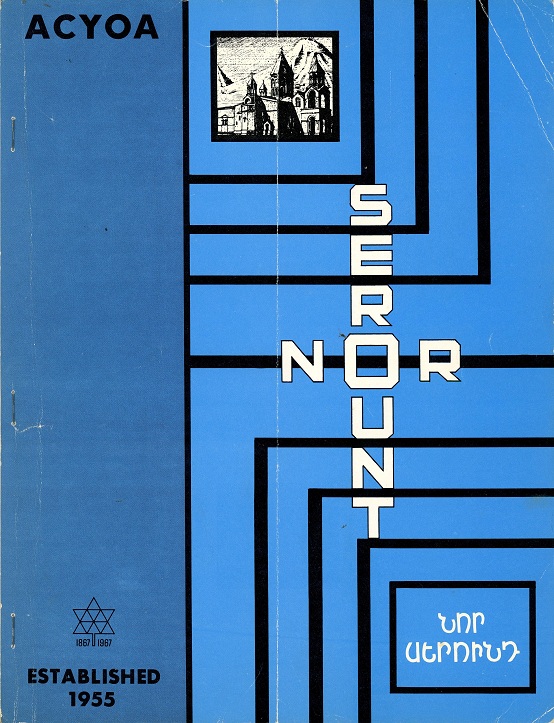 Rangement Rangement
Périodiques anglais
 | | Numéros disponibles : | Année 1968 (14e année) : numéros 2, 3, ; Année 1969 : numéros 1, 2, 3, 4, 5, 6, 7, 8 ; Année 1970 : numéros 1, 2, 3, 4, 5, 6, 7, 8, 9 ; Année 1971 : numéros 1, 2, 3, 4, 6, 7 ; Année 2006 : numéro 55 (Winter) ; Année 2007 : numéro 61 (Summer); Année 2013 : numéro 81 |
|---|
| Sous-titre : | |
|---|
| Adresse : | 920 Progress Avenue Scarborough, Ontario, Canada M1G 3T5 |
|---|
| Téléphone : | Tel: (416) 431-3001 Fax: (416) 431-0269 |
|---|
| Auteur : | Holy Trinity Armenian Church - Toronto |
|---|
| Périodicité : | Mensuel |
|---|
| Abonnement : | |
|---|
| Début : | 1955 |
|---|
| Fin : | |
|---|
| Imprimeur : | |
|---|
| Description : | 21,5 x 28 cm, 72 pages, couverture illustrée en couleurs |
|---|
| ISSN : | |
|---|
| Comm. paritaire : | |
|---|
| Site : | |
|---|
| E-mail : | |
|---|
| Commentaire : | www.torontoarmenianchurch.org
Père Jirayr Tashjian éditeur honoraire des premiers numéros |
|---|
| Mise à jour : | 2018 |
|---|
|
OOutreach | 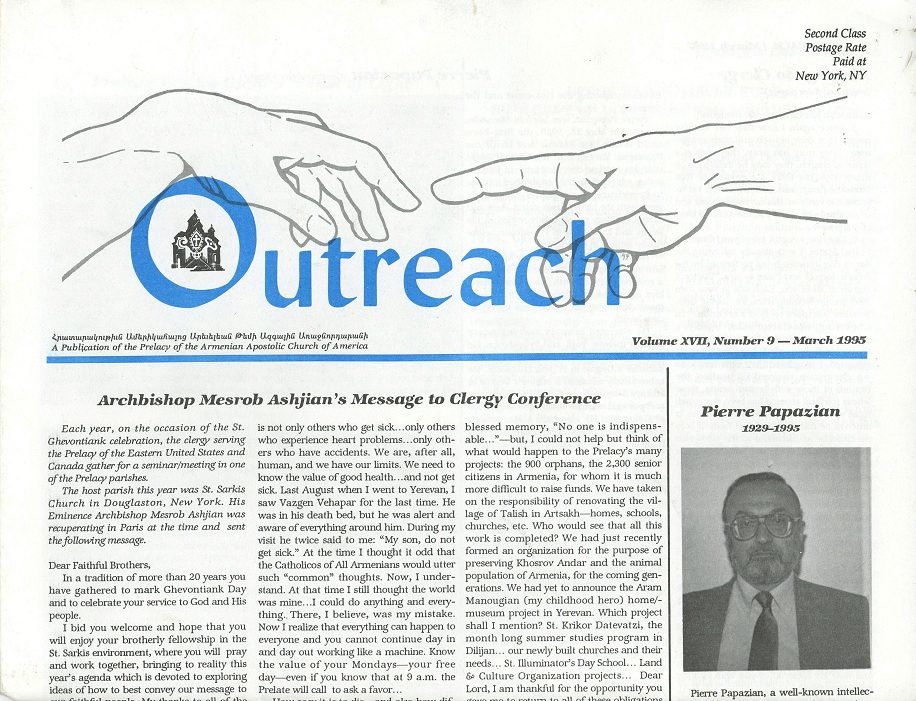 Rangement Rangement
Périodiques anglais
 | | Numéros disponibles : | 1995, numéros 9 et 10 |
|---|
| Sous-titre : | A publication of the Prelacy of the Armenian Apostolic Church of America |
|---|
| Adresse : | 138 East 39th Street, New York, NY 10016 |
|---|
| Téléphone : | (212) 689-7810 |
|---|
| Auteur : | Prelacy of the Armenian Apostolic Church of America |
|---|
| Périodicité : | Mensuel |
|---|
| Abonnement : | |
|---|
| Début : | 1995 |
|---|
| Fin : | 1995 |
|---|
| Imprimeur : | Printed in the United States of America |
|---|
| Description : | 18 x 44 cm, 4 pages |
|---|
| ISSN : | 10643087 |
|---|
| Comm. paritaire : | |
|---|
| Site : | |
|---|
| E-mail : | |
|---|
| Commentaire : | Archbishop Mesrob Ashjian, Prelate
Iris Papazian, Editor Mardirous Minas-Haftvani, Business Manager |
|---|
| Mise à jour : | 2012 |
|---|
|
PPari-Loor | 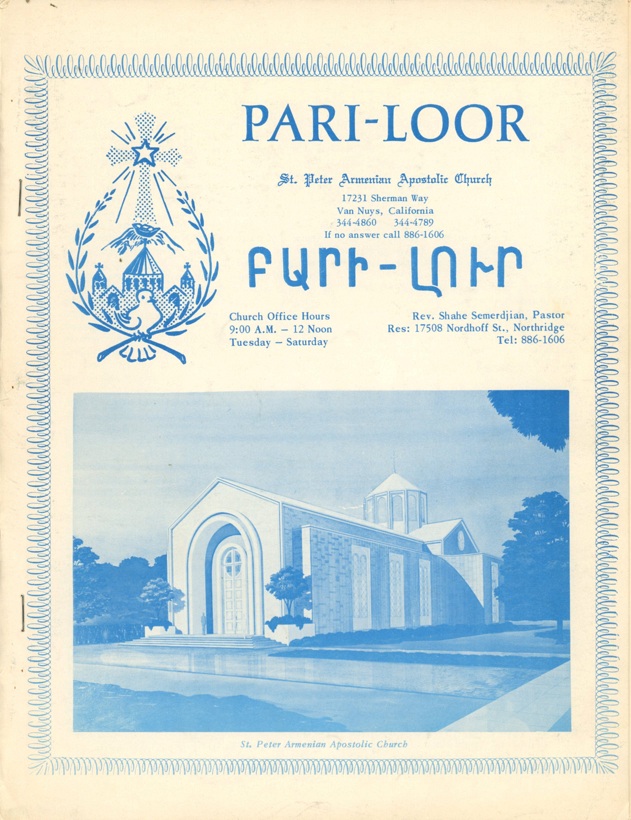 Rangement Rangement
Périodiques anglais
 | | Numéros disponibles : | 1968, numéro 10 (octobre) |
|---|
| Sous-titre : | |
|---|
| Adresse : | 17231 Sherman way, Van Nuys, California |
|---|
| Téléphone : | |
|---|
| Auteur : | St Peter Armenian Apostolic Church |
|---|
| Périodicité : | Mensuel |
|---|
| Abonnement : | |
|---|
| Début : | 1968 |
|---|
| Fin : | |
|---|
| Imprimeur : | Polycopié agrafé |
|---|
| Description : | 22 x 28 cm, 16 pages |
|---|
| ISSN : | |
|---|
| Comm. paritaire : | |
|---|
| Site : | |
|---|
| E-mail : | |
|---|
| Commentaire : | Bulletin paroissial |
|---|
| Mise à jour : | 2012 |
|---|
|
Polyphony - The Bulletin of the Multicultural History Society of Ontario | 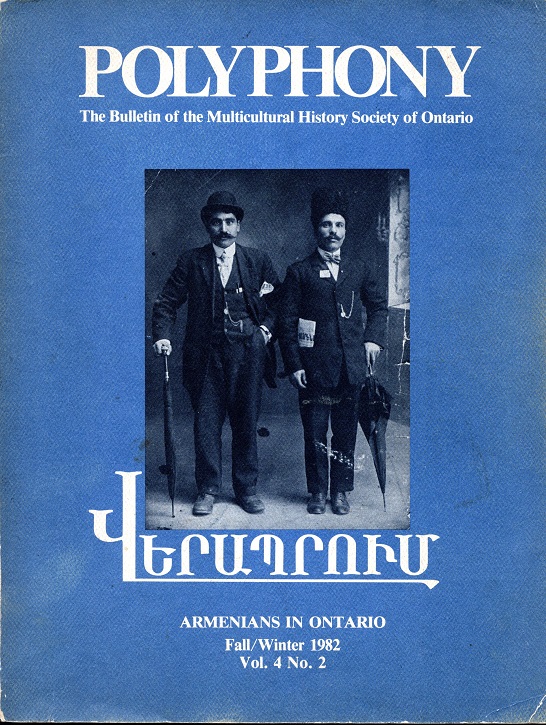 Rangement Rangement
Périodiques anglais
 | | Numéros disponibles : | Fall/Winter 1982, Vol. 4 No. 2 |
|---|
| Sous-titre : | Armenians in Ontario |
|---|
| Adresse : | Multicultural History Society of Ontario - 43 Queen's Park Cresceny East, Toronto, Ontario M5S2C3 |
|---|
| Téléphone : | 416-979-2973 (1982) |
|---|
| Auteur : | Robert F. Harney |
|---|
| Périodicité : | Semestriel |
|---|
| Abonnement : | |
|---|
| Début : | 1978 |
|---|
| Fin : | |
|---|
| Imprimeur : | Printed in Canada |
|---|
| Description : | 21 x 28cm, 136 pages, couverture illustrée |
|---|
| ISSN : | 0704-7002 |
|---|
| Comm. paritaire : | |
|---|
| Site : | |
|---|
| E-mail : | |
|---|
| Commentaire : | Issue editor : Isabel Kaprielian
Table des matières
| Contents | |
| Preface | 1 |
| Introduction | 5 |
| Immigration and Settlement of Armenians in Southern Ontario: the First Wave, by Isabel Kaprielian | 14 |
| A Brief Look at Relations between Canadians and Armenians: 1896-1920, by Rev. Harold J. Nahabedian | 28 |
| Genocide: 1915-22, by Eugenie Shehirian | 35 |
| The Georgetown Boys, by Jack Apramian | 43 |
| The Newcomers, by Isabel Kaprielian | 53 |
| My First Year in Toronto, 1923-24, by Oksen Teghtsoonian | 74 |
| The Armenian Revolutionary Federation in Canada: Past and Present, by Aram Aivazian | 78 |
| The First Armenian Church in Canada: St. Gregory the Illuminator, by Hygus Torosian | 87 |
| Armenians in Toronto: the Early Years, by Oksen Teghtsoonian | 95 |
| Armenian Folk-Belief with Special Emphasis on Veejag, by Isabel Kaprielian | 101 |
| The Musical Repertory of Early Armenian Set tiers, by Hasmig Injejikian | 107 |
| The Canadian Armenian Congress, by Yervant Pastermadjian | 117 |
| Portrait of the Armenian Community Today | 122 |
|
|---|
| Mise à jour : | 2023 |
|---|
|
Pro Oriente | 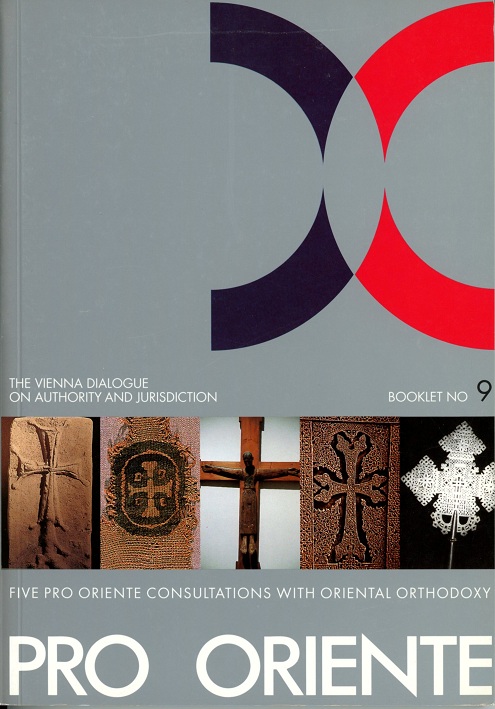 Rangement Rangement
Périodiques anglais
 | | Numéros disponibles : | 1 (1991à à 9 (1998) |
|---|
| Sous-titre : | |
|---|
| Adresse : | Hofburg, Marschallstiege 11, A-100 - Vienna |
|---|
| Téléphone : | 533-80-21 |
|---|
| Auteur : | Pro Oriente |
|---|
| Périodicité : | Annuel |
|---|
| Abonnement : | |
|---|
| Début : | 1991 |
|---|
| Fin : | |
|---|
| Imprimeur : | Ferdinand Berger and Söhne, Austria |
|---|
| Description : | 17 x 24 cm, 140 ages, cover photo in colors |
|---|
| ISSN : | ISBN 390118896 |
|---|
| Comm. paritaire : | |
|---|
| Site : | |
|---|
| E-mail : | |
|---|
| Commentaire : | Issue number 9, 1998 K. M. George Kondothra
The present volume on Authority and Jurisdiction is the result of a Study Seminar organized by the PRO ORIENTE Foundation as the fourth in a series. These study seminars which have brought together, over a period of five years, theologians and specialists on issues like Primacy, Councils and Conciliarity, Ecclesiology and Unity of the Church. Authority and Jurisdiction are on offshoot of the celebrated Vienna Dialogues between theologians of the Roman Catholic and Oriental Orthodox Churches sponsored by PRO ORIENTE since 1971.
In the unofficial conversations of the Vienna Dialogues, fundamental Christologi-cal issues, which had divided the Church since the Council of Chalcedon 451, where settled and agreements reached. The Study Seminars took up for further clarification theological and ecclesiological issues that remained between the Roman Catholic and Oriental Orthodox Churches as obstacles in their way to establishing eucharistic communion. On the firm footing of the Vienna Dialogues, these Seminars have enhanced mutual understanding and further agreements between the two ancient Church traditions.
The issue of Authority and Jurisdiction, however, remains to be the major (probably the last?) bastion of discord and disagreement to be confronted with on the way to communion. In the historical evolution of the Churches in the West and the East, different structures of authority were developed at local, regional and global levels. Primatial sees like Patriarchates and Catholicosates became the hub of authority structure in different churches. In the light of the contemporary globalization of the formerly "local" churches through mission and diaspora, the issue of primacy in the churches acquired a new dimension. In the dialogue between the Roman Catholic Church and the Oriental Orthodox Churches, the traditional question of the primacy of the see of Rome and the ministry of the Bishop of Rome naturally loomed large.
Some of the convergence points and the topics for further discussion and elucidation are briefly outlined in the communique of the Fourth Study Seminar.
The Seminar was partly a response to the call of Pope John Paul II in his encyclical Ut Unum sint to open a wider discussion on the question of the authority of the Bishop of Rome in view of the new millennium and the aspiration of Christians all over the world for close unity and cooperation.
Our profound gratitude goes to the PRO ORIENTE Foundation, its founder Francis-cus Cardinal Konig, whose gracious presence in some sessions of this seminar enriched us, and to Alfred Stirnemann, President of the PRO ORIENTE Foundation, whose highly informed and indefatigable ecumenical enthusiasm and remarkable organizational abilities mede this seminar and other such activities of the foundation a major step forward in the fellowship of our Churches.
Orthodox Theological Seminary Kottayam, November 2nd, 1998
TABLE OF CONTENTS
K.M. George Kondothra: Preamble 5
Alfred Stimemann/Gerhard Wilflinger: Foreword by the Editors 7
Philipp Harnoncourt: Scholarly Achievement 8
Program 11
List of participants 12
Papers and discussions:
Herve Legrand OP: The Nature of Authority and Jurisdiction in the Catholic Tradition 14
Kondothra K.M. George: The Nature of Authority and Jurisdiction in the Oriental Orthodox Tradition 27
Amba Bishoy: The Practice of Authority and Jurisdiction in the Coptic Orthodox Tradition 35
Mar Gregorios: The Practice of Authority and Jurisdiction in the Syrian Orthodox Tradition 47
Mesrob K. Krikorian: The Practice of Authority and Jurisdiction in the Armenian Orthodox Tradition59
Abba Gabriel: The Practice of Authority and Jurisdiction in the Ethiopian Orthodox Tradition78
Sebou Sarkissian: Authority and Jurisdiction in the Armenian Church with Special Reference to the Special Characteristics of the Practice of Authority and Jurisdiction in the Catholicosate of Cilicia88
Ivan Zu2ek SJ: The Practice of Authority and Jurisdiction in the Oriental Catholic Tradition101
Richard Potz: The Practice of Authority and Jurisdiction in the Latin Tradition123
Bruno Primetshofer: The Practice of Authority and Jurisdiction in the Latin Tradition128
Communique" of the Fourth PRO ORIENTE Study Seminar ,,Authority and Jurisdiction". 137
|
|---|
| Mise à jour : | 2011 |
|---|
|
SSt. Nersess Theological review | 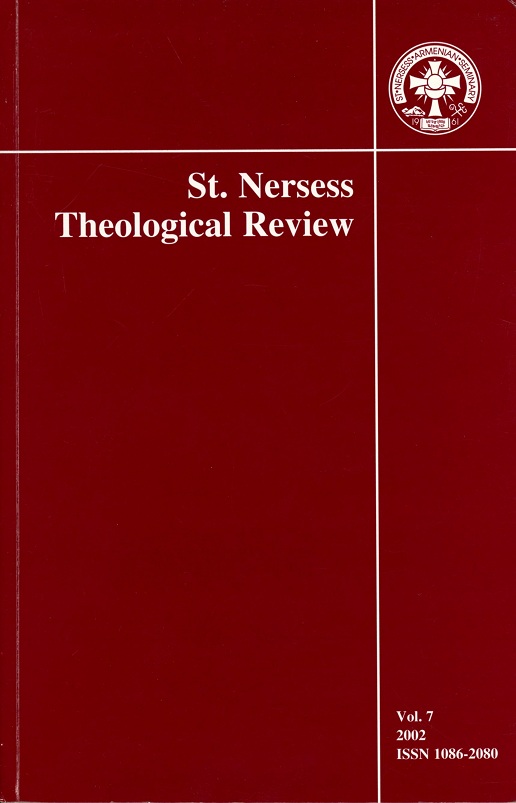 Rangement Rangement
Périodiques anglais
 | | Numéros disponibles : | Année 1996 : numéros 1, 2
Année 1997 : numéros 1, 2
Année 1998 : numéro 1-2
Années 2000-2001 : numéro 5-6
Année 2002 : non numéroté |
|---|
| Sous-titre : | |
|---|
| Adresse : | St. Nersess Armenian Seminary, 150 Stratton Road, New Rochelle, NY 10804 |
|---|
| Téléphone : | USA (914) 636-2003 |
|---|
| Auteur : | |
|---|
| Périodicité : | Semestriel |
|---|
| Abonnement : | $ 25 per year |
|---|
| Début : | 1996 |
|---|
| Fin : | |
|---|
| Imprimeur : | Printed in the USA |
|---|
| Description : | 15 x 23 cm, 126 pages |
|---|
| ISSN : | 1086-2080 |
|---|
| Comm. paritaire : | |
|---|
| Site : | |
|---|
| E-mail : | info@stnersess.edu |
|---|
| Commentaire : | The St. Nersess Theological Review (SNTR) is published semi-annually by St. Nersess Armenian Seminary. The SNTR considers articles, short notes, review articles and book reviews in all fields related to Christianity in the Armenian Church; e.g. theology, liturgy, philosophy, ethics, biblical studies, canon law, church history, ecumenics, literature, fine arts, archaeology, and interdisciplinary studies, as well as translations of Armenian patristic texts. |
|---|
| Mise à jour : | 2024 |
|---|
|
TThe Armenian Church | 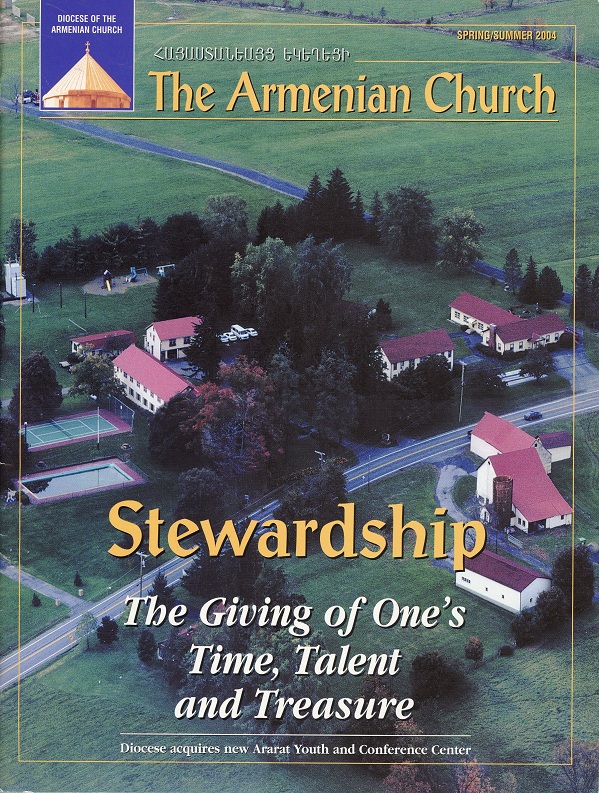 Rangement Rangement
Périodiques anglais
 | | Numéros disponibles : | Année 1968 : October
Année 1969 : December
Année 1970 : January
Année 1993 : January, February, March, April, May, August/September , October/November
Année 1994 : January/February, March, April, May, June, August/September, October/November, December
Année 1995 : January, February/March, April/May/June, July/August, November/December
Année 1996 : March/April, May/June/July, Special Edition
Année 1997 : January/february, March/April, Autumn
Année 1998 : Volume XII, number 1 (Winter), 2, 3
Année 1999 : Volume XIII, number 1 (Spring), Summer, Fall, Winter
Année 2000 : Spring
Année 2002 : Fall, Winter
Année 2004 : Spring/Summer |
|---|
| Sous-titre : | |
|---|
| Adresse : | THE ARMENIAN CHURCH, 630 Second Avenue, New York, NY 10016-4806 |
|---|
| Téléphone : | |
|---|
| Auteur : | Diocese of the Armenian Church of America (Eastern Diocese) |
|---|
| Périodicité : | Trimestriel |
|---|
| Abonnement : | |
|---|
| Début : | 1968 |
|---|
| Fin : | 2004 |
|---|
| Imprimeur : | |
|---|
| Description : | 21 x 27 cm, 28 pages, couverture illustrée en couleurs |
|---|
| ISSN : | 1075-7066 |
|---|
| Comm. paritaire : | |
|---|
| Site : | |
|---|
| E-mail : | |
|---|
| Commentaire : | Texte majoritairement en anglais
THE ARMENIAN CHURCH is a publication of the Diocese of the Armenian Church of America (Eastern Diocese)
630 Second Ave., New York, NY 10016-4806.
Submissions should be sent to the attention of the editor.
His Eminence Archbishop Khajag Barsamian, Primate, Arpie Nakashian McQueen Editor , Very Rev. Fr. Krikor Maksoudian , Editor of Armenian Section , Armen Garabedian Art Direction and Design, Contributors: Jake Goshert Chris Zakian, Valerie A. McQueen , Editorial Assistant
THE ARMENIAN CHURCH welcomes readers' comments by e-mail at tac@armeniandiocese.org or by U.S. mail correspondence to the address below.
Change of address?
In order to keep our records up to date and your receipt of THE ARMENIAN CHURCH on time and accurate, kindly inform us of any corrections, changes of address, etc., as they take place. Send all corrections, along with the old address and incorrect names, to: THE ARMENIAN CHURCH, 630 Second Avenue, New York, NY 10016-4806. Tel: (212) 686-0710.
THE ARMENIAN CHURCH, (ISSN 1075-7066) is published quarterly by the Diocese of the Armenian Church (Eastern), 630 Second Avenue, New York, NY 10018-4806. Postmaster: send address change to THE ARMENIAN CHURCH, c/o Diocese of the Armenian Church of America (Eastern), 630 Second Avenue, New York, NY 10016-4806. |
|---|
| Mise à jour : | 2012 |
|---|
|
The Armenian Guardian | 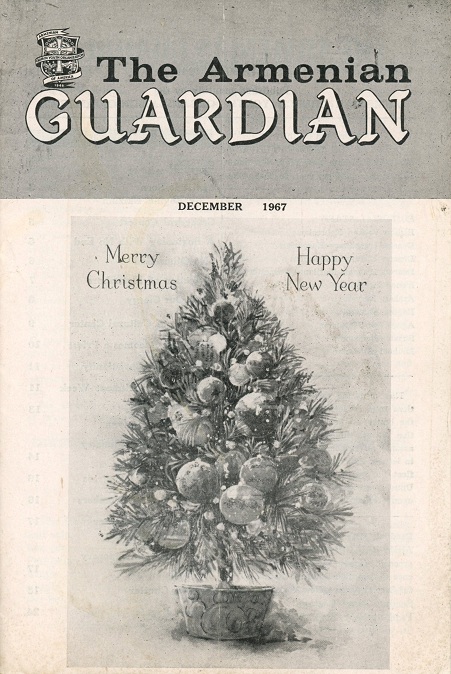 Rangement Rangement
Périodiques anglais
 | | Numéros disponibles : | 1953 : Vol VI, No 7, July
1965 : Vol XIX, No 2, Februar, No 4, April
1967 : Vol XXI, No 12, December |
|---|
| Sous-titre : | |
|---|
| Adresse : | 630 Second Avenue, New York N. Y. 10016, USA |
|---|
| Téléphone : | |
|---|
| Auteur : | Armenian Church Youth Organization of America |
|---|
| Périodicité : | Mensuel |
|---|
| Abonnement : | $ 3,00 per year |
|---|
| Début : | 1953 |
|---|
| Fin : | 1967 |
|---|
| Imprimeur : | |
|---|
| Description : | 15,5 x 23 cm, 24 pages |
|---|
| ISSN : | |
|---|
| Comm. paritaire : | |
|---|
| Site : | |
|---|
| E-mail : | |
|---|
| Commentaire : | EDITORIAL STAFF (1967) : Bishop Vasken Kebresian, Deacon Hovhannes Kasparian, Deacon Krikor Maksoudian, Deacon Dickran Metjian (Worcester), Irene Cheteyan, Arshag Daiyan, liegina Ekizian, Agnes Der Mattosian, Susan Shamamian, Michael Simonian |
|---|
| Mise à jour : | 2012 |
|---|
|
The Armenian Mirror-Spectator | 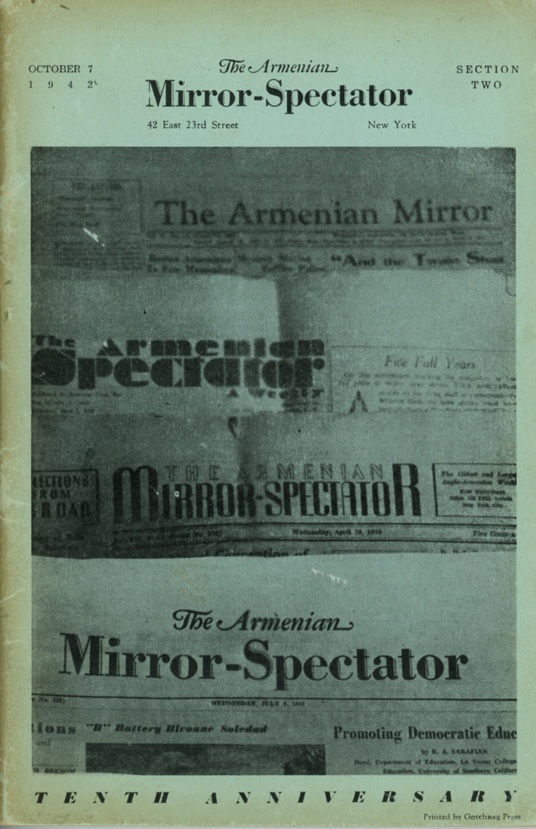 Rangement Rangement
Périodiques anglais
 | | Numéros disponibles : | 1942, October 7 |
|---|
| Sous-titre : | |
|---|
| Adresse : | 42 East 23rd Street, New York |
|---|
| Téléphone : | |
|---|
| Auteur : | |
|---|
| Périodicité : | Mensuel |
|---|
| Abonnement : | |
|---|
| Début : | 1942 |
|---|
| Fin : | |
|---|
| Imprimeur : | Gorelmag Press |
|---|
| Description : | 15,5 x 23,5 cm, 64 pages, couverture illustrée |
|---|
| ISSN : | |
|---|
| Comm. paritaire : | |
|---|
| Site : | |
|---|
| E-mail : | |
|---|
| Commentaire : | Editorial
During the late nineteen twenties the Armenian American community suddenly became aware of the existence of a lieu generation. The sons and daughters of the immigrants who came to America during the first quarter of the present century were reaching the stage of young manhood and young womanhood. The startling appearance of this active, energetic, and physically attractive generation was most welcome. The youngsters attended the American public schools, held their own as scholars and as athletes, in competition with their fellow American schoolmates, and spoke kings English. not with the accent of the parents from Sivas or Harppot, but as any authentic native "Amerigatzi." On the whole, they were a well behaved and wholesome lot.
But all was not as well as it appeared on the surface. The vast differences of geographic background language, and education had created a gap between the old and the new and that gap was growing wider every day. Though living in the same country and often under the same roof, the immigrant parents and their American born sons and daughters, in some respects, were as people from two different planets. Yet, whereas the elders, through the force of circumstances, had acquired a fairly adequate knowledge of the English language and were making steady progress in their appreciation of the problems of America and their American children, the latter, deprived of the mother tongue and strangers to the cultural and historical background of their parents, found it difficult to understand the older generation. Considering themselves as superior, by virtue of their American birth, many youngsters had begun to look down on their parents who had come across the seas.
One of the tragedies in parenthood is the absence of sympathy and understanding on the part of the offsprings towards their parents. All fathers and mothers crave the warmth that comes as a partial reflection of the love they lavishly shower on their sons and daughters. Woe to the home that fails to achieve a balance of mutual trust and affection. The root of many a psychological and sociological problem goes back to the lack of understanding between the parents and their children, between the old and the new.
Something had to be done, therefore, to bridge the gap between the two generations. There was need for an effective medium to create a mutual understanding. There was need to free the minds of the young Armenian Americans from any notion of racial inferiority. It was necessary to explain to them the background of their parents and to arouse their sympathy at least for some of the finer aspirations of their fathers and mothers.
And there could be no question that that medium should he in the language the new generation could understand. Thus was born in Boston, on July 1, 1912, the first English language Armenian weekly, "The Armenian Mirror."
Nine months later, April 1933, appeared the Armenian Spectator, on March, 1934 “HairenkWeekly." and soon after The "Youth." On January 1, 1939, occurred the merger of the two oldest papers. "The Mirror" and the "Spectator" under the present title
The present editors of The Mirror-Spectator owe a great deal to their predecessors, Chrakian, Atamian, Nicholas Nazar, and Toumanyan of The Armenian Mirror, and Tashjian, Derounian and Nalbandian of The Spectator, for their part in the creation and growth of this publication. It was they who pioneered: it has been the ambitions of their successors to keep up the high standards set before them. The present editors, owe a vote of thanks to the ADL party, the publishers, for the complete freedom they have enjoyed in the matter of editing this paper, not as the mouthpiece of a political faction, but as an organ dedicated to the service of all groups and movements that strive to accomplish useful objectives. Words fail when we try to describe the loyalty and devotion of our staff, Armine Dikijian-Bozian, Helen Tertian, Rose Minassian, Zabelle Kazanjian. Frances Paelian,. Anarig Timourian,Levon Zakarian and Haig Dikijian. Unfortunately, space does not permit us to do justice to our many valuable contributors and former colleagues.
We do not wish to indulge in self-evaluation, but we are confident that we have been effective in creating harmony between the immigrant and American born members of our community. We are proud that in our efforts to combat the feeling of racial inferiority we have consistently steered clear of the idiocies of racism, super-patriotism, or self-centered nationalism. We have emphasized—sincerely, and not for outside consumption—that loyalty In America comes before all other considerations. Yet we have loved America without indulging in the provincial hypocrisy of "America firstism."We are extremely proud that bigotry has not been one of our failings.
Our guiding aim could be epitomized in the words of Fenelon
More than mv family I love my country:
More than mv country I love the human race.
Table of Contents
Editorial 1
Letetr from Archbishop Garegin 3
Blood of a Nation, William Phillips Chad 4
Death, Emmanuel Varandyan 5
In Peace With Himself, Artin Shalian 12
Controlling Color For Dramatic Effect, Rouben Mamoulian 13
The Favorite Of God, Themara Tegour 20
The Proposal, Mardie Jay Bakjian 21
Let My Son, Ara Timourian 26
Education in Armenia, K. A. Sarafian 27
God's Intervention, Anarig Timourian 32
Khashlama Serenade, Edward Tarjan 33
The First Armenian Newspaper in America 40
What is Fascist-Mindedness?, Avedis Dorouninn 41
Our Flag, Florence Parseghan 45
Closepup of a Hollywoodope, P.K. Thomajian 46
Disciple of the Ahbot Mekhitar, Leon Surmelian 47
To Armenia, Elishe Charentz. translated by Hope Kasabian 65 |
|---|
| Mise à jour : | 2012 |
|---|
|
The Eternal flame | 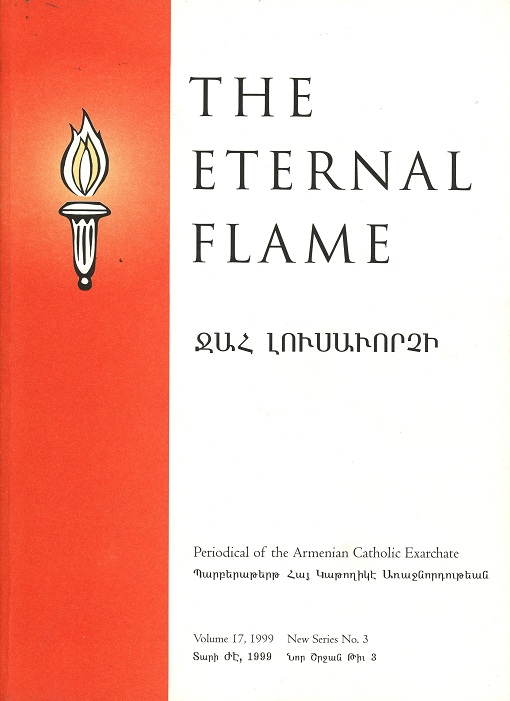 Rangement Rangement
Périodiques anglais
 | | Numéros disponibles : | Volume 2, number 5-8 (winter 1984), 17, 1999, volume 18, 2000 |
|---|
| Sous-titre : | ՋԱՀ ԼՈԻՍԱԻՈՐՉԻ - Պարբերաթերթ Հայ Կաթողիկէ Առաջնորդութեան |
|---|
| Adresse : | 110 East 12th Street, New York NY 10005-5395 |
|---|
| Téléphone : | |
|---|
| Auteur : | Apostolic Exarchate for Armenian in the USA and Canada |
|---|
| Périodicité : | Mensuel |
|---|
| Abonnement : | |
|---|
| Début : | 1984 |
|---|
| Fin : | 2000 |
|---|
| Imprimeur : | |
|---|
| Description : | 18 x 24 cm, 80 pages, couverture illustrée en couleurs |
|---|
| ISSN : | |
|---|
| Comm. paritaire : | |
|---|
| Site : | |
|---|
| E-mail : | |
|---|
| Commentaire : | Bilingue anglais/arménien |
|---|
| Mise à jour : | 2012 |
|---|
|
The Messager - ՍՈՒՐՀԱՆԴԱԿ | 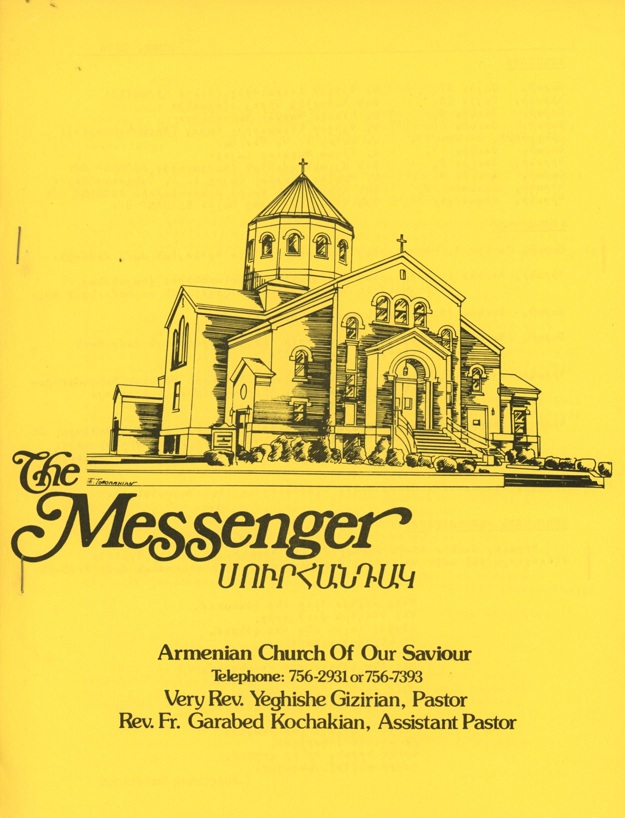 Rangement Rangement
Périodiques anglais
 | | Numéros disponibles : | 1978, June ; 1981, February-March |
|---|
| Sous-titre : | |
|---|
| Adresse : | 87 Salisbury Street, Worcester, massachussets 01609 |
|---|
| Téléphone : | |
|---|
| Auteur : | Armenian Church of Our Saviour |
|---|
| Périodicité : | Mensuel |
|---|
| Abonnement : | |
|---|
| Début : | 1978 |
|---|
| Fin : | |
|---|
| Imprimeur : | Polycopie |
|---|
| Description : | 21,5 x 28 cm, 12 pages |
|---|
| ISSN : | |
|---|
| Comm. paritaire : | |
|---|
| Site : | |
|---|
| E-mail : | |
|---|
| Commentaire : | Rev. Fr. Garabed Kochakian, Pastor |
|---|
| Mise à jour : | 2012 |
|---|
|
The Monthly Bulletin of the Armenian Evangelical Church of New York | 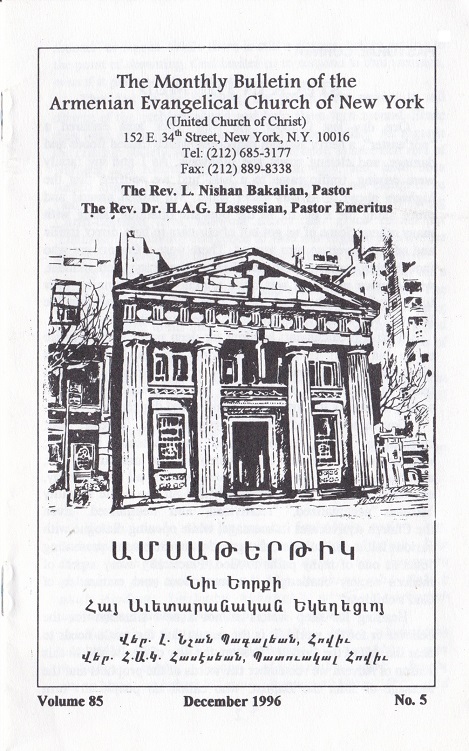 Rangement Rangement
Périodiques anglais
 | | Numéros disponibles : | Volume 84 : numéros 8 (avril 1996) et 10 (juin 1996)
Volume 85 numéros 3 (novembre 1996) et 5 (décembre 1996) |
|---|
| Sous-titre : | United Church of Christ |
|---|
| Adresse : | 152 East 34 th Street, New York, NY 10016 |
|---|
| Téléphone : | (212) 685-3177 |
|---|
| Auteur : | The Rev. L. Nishan Bakalian |
|---|
| Périodicité : | Mensuel |
|---|
| Abonnement : | Yearly $10.00 |
|---|
| Début : | 1996 |
|---|
| Fin : | 1996 |
|---|
| Imprimeur : | |
|---|
| Description : | 11 x 18,5 cm, 12 pages, illustration NB sur la couverture, fascicule agrafé |
|---|
| ISSN : | |
|---|
| Comm. paritaire : | |
|---|
| Site : | |
|---|
| E-mail : | |
|---|
| Commentaire : | En anglais, avec quelques textes en arménien Ne paraît pas en juillet et aout |
|---|
| Mise à jour : | 2019 |
|---|
|
The Mother Church - ՄԱՅՐ ԵԿԵՂԵՑԻ | 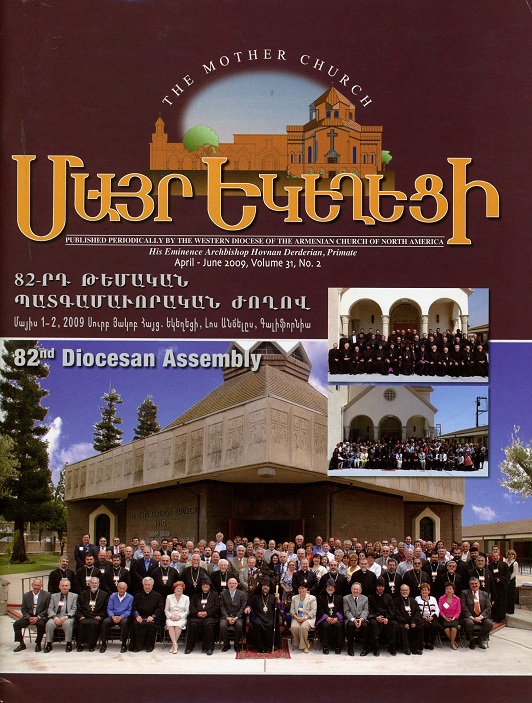 Rangement Rangement
Périodiques anglais
 | | Numéros disponibles : | Année 1996 : volume 18, num 1, 2, 3,4, ; Année 1997 : volume 19, num 2, 3,6 ; Année 1998 : volume 20, num 1,2 ; Année 1999 : volume 21, num 1, 2, 3,4 ; Année 2000 : volume 22, num 1, 2, 3, 4 ; Année 2001 : volume 23, num 1, 2, 3, 4,5 ; Année 2002 : volume 24, num 1, 2, 3, 4, ; Année 2003 : volume 25, num 1, 2, 4 ; Année 2005 : volume 27, num 2-3 ; Année 2008 : volume 30, num 2 ; Année 2009 : volume 31, num 2 |
|---|
| Sous-titre : | |
|---|
| Adresse : | 3325 N. GLENOAKS BLVD., BURBANK, CA 91504 |
|---|
| Téléphone : | |
|---|
| Auteur : | Western Diocese of the Armenian Church of North America |
|---|
| Périodicité : | Trimestriel |
|---|
| Abonnement : | |
|---|
| Début : | 1996 |
|---|
| Fin : | 2009 |
|---|
| Imprimeur : | |
|---|
| Description : | 44 x 29,5 cm, 12 pages, en anglais majoritaire et arménien, puis format magazine, 21 x 29, couverture illustrée en couleurs, 36 pagesrs, 36 pages |
|---|
| ISSN : | |
|---|
| Comm. paritaire : | |
|---|
| Site : | |
|---|
| E-mail : | |
|---|
| Commentaire : | |
|---|
| Mise à jour : | 2012 |
|---|
|
The Treasury | 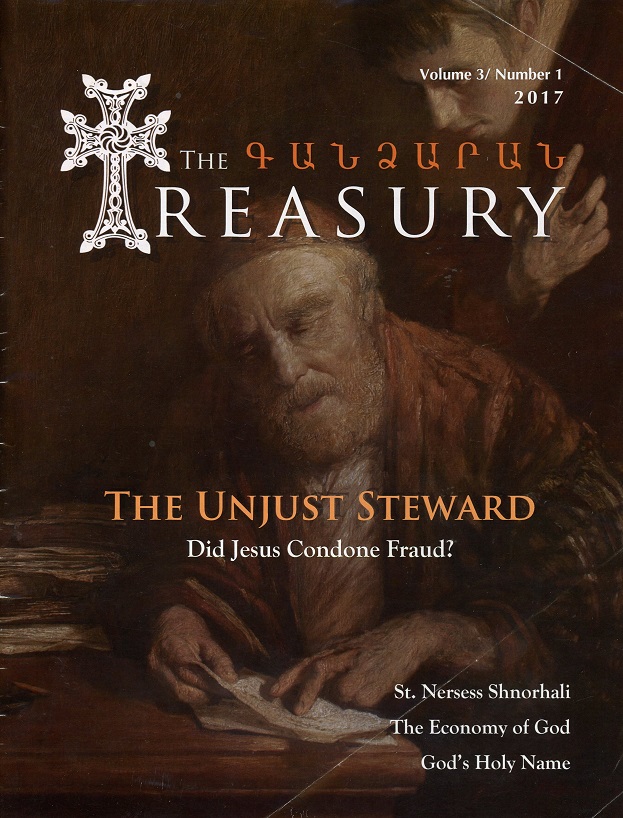 Rangement Rangement
Périodiques anglais
 | | Numéros disponibles : | 2017 (volume 3), Number 1 |
|---|
| Sous-titre : | Official publication of the Fellowship of St. Voski |
|---|
| Adresse : | P.O. Box 377 Sutton, MA 01590 |
|---|
| Téléphone : | |
|---|
| Auteur : | Fellowship of St. Voski, editor in chief Dr.André Markarian |
|---|
| Périodicité : | Mensuel |
|---|
| Abonnement : | |
|---|
| Début : | 2017 |
|---|
| Fin : | |
|---|
| Imprimeur : | |
|---|
| Description : | 21,5 x 28 cm, 22 pages, couverture illustrée en couleurs |
|---|
| ISSN : | |
|---|
| Comm. paritaire : | |
|---|
| Site : | |
|---|
| E-mail : | |
|---|
| Commentaire : | “The Fellowship of St. Voski” (aka Nor Voskiank) is a non-profit organization working toward the revival and restoration of Armenian Orthodox theology and life within the Armenian Church. Through publication of practical educational resources like The Treasury (aka Kantsaran), its goal is to help cultivate a thriving, united, worldwide Armenian Christian community |
|---|
| Mise à jour : | 2018 |
|---|
|
VVoice | 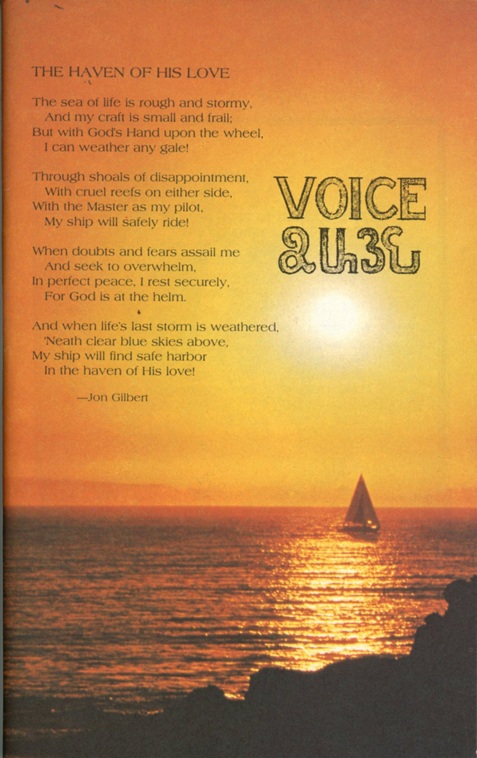 Rangement Rangement
Périodiques anglais
 | | Numéros disponibles : | Numéro spécial |
|---|
| Sous-titre : | |
|---|
| Adresse : | 4473 30th Street, San Diego, California 92116 |
|---|
| Téléphone : | |
|---|
| Auteur : | St John Armenian Apostolic Church |
|---|
| Périodicité : | Mensuel |
|---|
| Abonnement : | |
|---|
| Début : | 1986 |
|---|
| Fin : | |
|---|
| Imprimeur : | ChristianArt, USA |
|---|
| Description : | 15,5 x 23,5 cm, 64 pages, couverture illustrée |
|---|
| ISSN : | |
|---|
| Comm. paritaire : | |
|---|
| Site : | |
|---|
| E-mail : | |
|---|
| Commentaire : | THIS BOOKLET IS DEDICATED TO THE MEMORY OF OUR BELOVED SON
HRAND LEVON ARAKELIAN
WHO GAME INTO OUR LIVES THIRTY-FOUR YEARS AGO, AND WAS SUDDENLY CALLED HOME.
HIS DEPARTURE HAS LEFT A TREMENDOUS VOID IN OUR LIVES, BUT THE SWEET AND UNFORGETTABTZ BRIDGES OF HIS MEMORIES WILL KEEP US IN COMMUNION AND CARRY US TOWARD OUR DESTINATION, WHEN WE SHALL ONCE AGAIN REUNITE IN THE LORD. |
|---|
| Mise à jour : | 2012 |
|---|
|
|